Interview 044 • May 20th 2016
- Interview by: Lou Noble
- Tim Soter Portraits by: Simon Zachary Chetrit
About Tim Soter
Tim Soter is known for his active search for interesting environments as well as his photographic sense of humor.
He was raised in a log cabin, studied photography in Pennsylvania and in 1994 moved to Brooklyn, NY. He immediately began a personal project documenting the underground electronic music scene for a period of seven years. Tim moved on to editorial and commercial photography and his clients include Starbucks, Ford, Vogue, Maxim, Spin and Rolling Stone as well as EmblemHealth, Adidas and Coca-Cola.
He has photographed the President of Syria, spent the afternoon at Slash's house, and once had nine seconds to shoot Daft Punk eating corn on the cob.
Links
Foreword
When we were given the opportunity to interview Tim Soter here at TPJ, we jumped on it like piranha’s ready to feast. As a long standing member of the photographic community, the way he speaks about finding his various peers and mentors is inspiring, and just goes to show you that if you never try, you’ll never know what can truly happen. Being able to learn through him was like learning from a lineage of photographers, which is rarer and rarer in our ever increasingly digital world. I admire Tim’s style, its sheer honestly, and the way he can tie everything back to the personal connections he has made over the span of his career.
-SuzAnne Helen Steben (Managing Editor)
This interview has been edited for clarity and content.
Interview
Let us begin: How did you get started in photography?
So I got started in photography because I went to a small state school in Pennsylvania called Kutztown University. Kutztown, again it’s a small state school. They’re known because they have a good art department and the other thing that town is known for, it’s the birthplace of Keith Haring.
Ok, yeah.
So I go to school and I’m majoring in art, I’ve always been artistically inclined, I really like art, and I decide I’m going to be a printmaker, I’m making all these etchings and things, I’m going to be a printmaker.
And in that school, you had to take five introductory courses before you can declare yourself something. So you had to take intro to printmaking, painting, drawing, sculpture, and photography.
I had taken all the intro classes except for photography, because I thought that was for monkeys.
Hahahahaha.
I thought, it was like, you know, I thought it was like a craft, like basket weaving. I was so headstrong as a 19 year old. I thought. “there’s No gesture in there. It’s this Cold box. This is useless to me. I’m a printmaker.”
So when I finally was forced, the school was very smart, they forced me to take intro to photography, I realized how much I love photography.
Hahahahhaha!
And then I was trying to make photographs out of these old metal plates. I was making Xeroxes and using Xerox techniques to photo-etch Xeroxes. Literally making “ye olde time ye olde photographs” but not smart enough to realize that’s what I was doing in printmaking class.
So the end of this long story, I had this photography professor, Paul Laincz, and right before Thanksgiving he would give a lecture that was the history of photography, and he condensed it down to three slide projectors that are all dissolving. And this is in a little bunker of a room, and this is in the 90’s.
So he would smoke cigarettes and he would pace around, and he had this thick Boston accent and he’d be like, “Alright. This here’s, ahh, Robert Capa ‘Death of Spanish Loyalist.’ A lot of people think this photo mighta been faked…ya can’t fake Death!” And then he would go off on some tangent.
So that day, I left that day, that slide show, walked up to hill back to my room at school, and that day I said, “I will be a photographer for the rest of my life no matter what, even if I don’t make any money at it,” it was, without being too poetic, it really was like a religious calling. I just knew that my brain connected so closely to making things with this little box, I would do this forever, and I really felt that, really strongly. And I still feel like that, I still love photography.
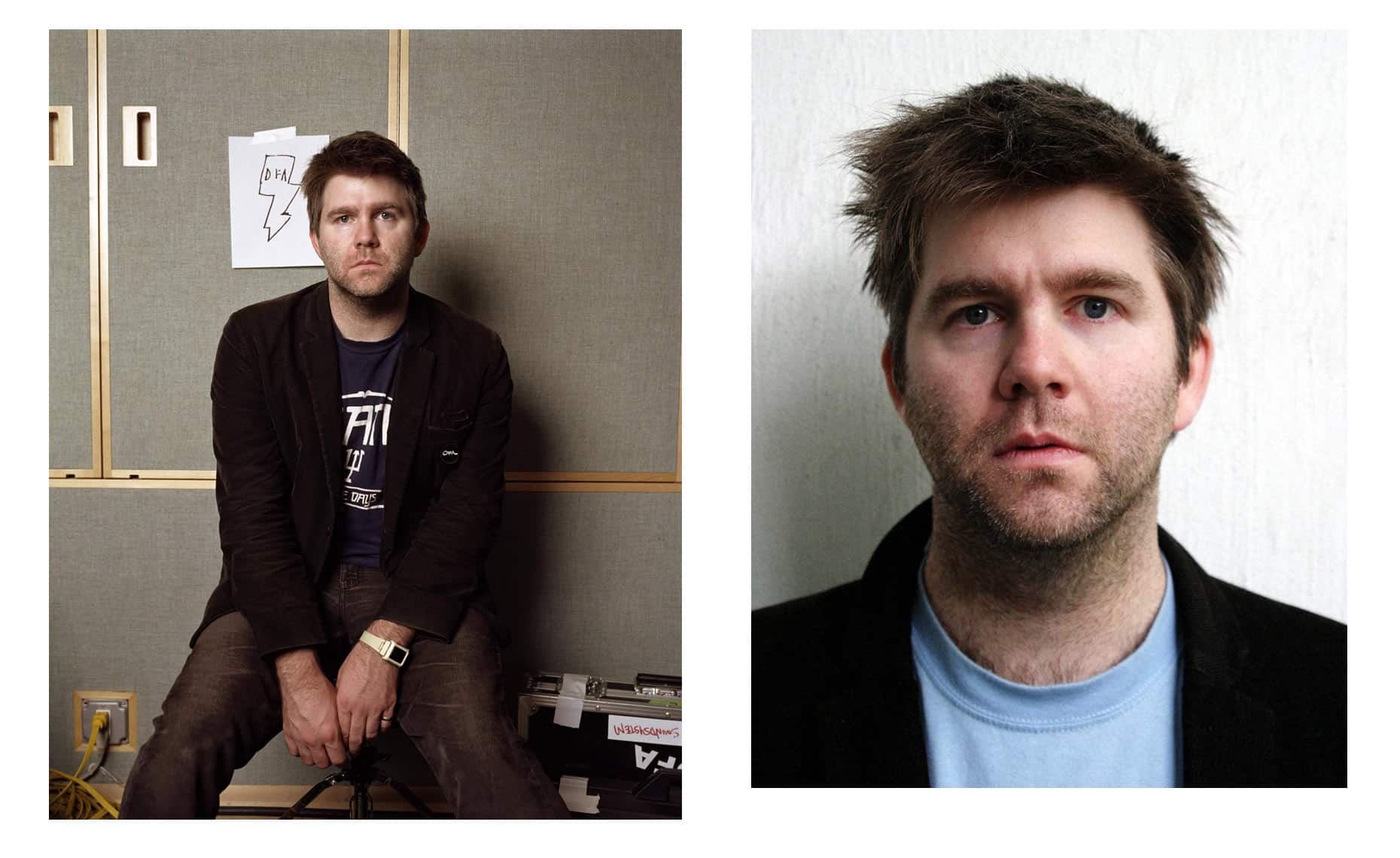
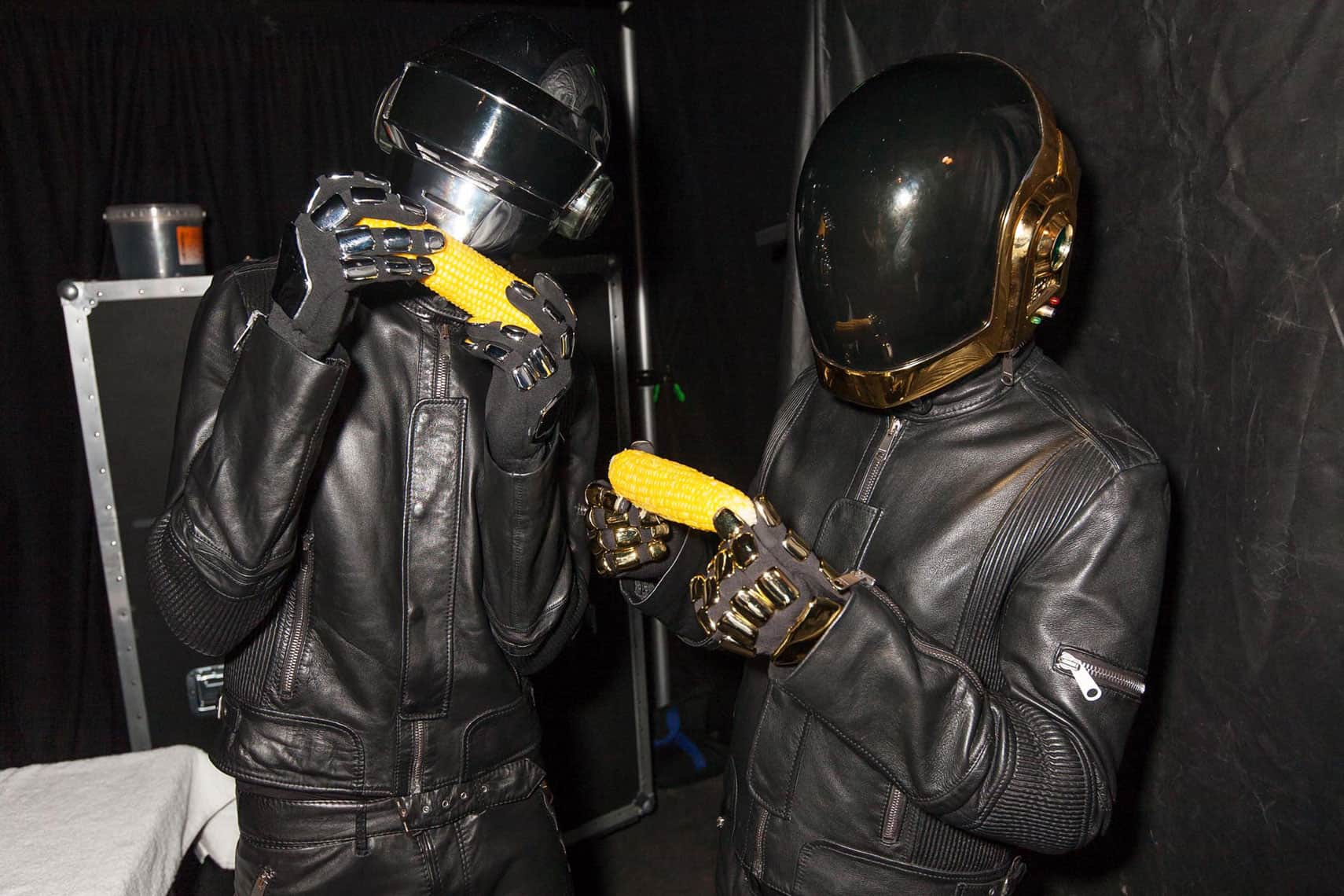
1. James Murphy | DFA Records – Tim Soter
2. Daft Punk – Tim Soter
That’s good!
So that’s the long answer!
The long answers are what we want.
Okay okay.
We’re big fans of…the robust responses.
Oh good, good.
Did you go to New York right after that? Right after you finished school?
Yeah, I moved to New York City in 1994, just as soon as I graduated. I asked everybody out of my friends if anybody would move with me…no one would move to New York City with me. Except for one person, who was at that time an ex-girlfriend, and so we weren’t dating anymore but she’s said, “I want to move to New York and we can do this,” and I said, “alright we can do this.” So she and I ended up moving to New York and we fought for the entire first year that we lived together, and then she moved out and moved on. We were literally, this school, was in Amish country in Pennsylvania. So, I feel like I’ve had a good photographic life here in New York.
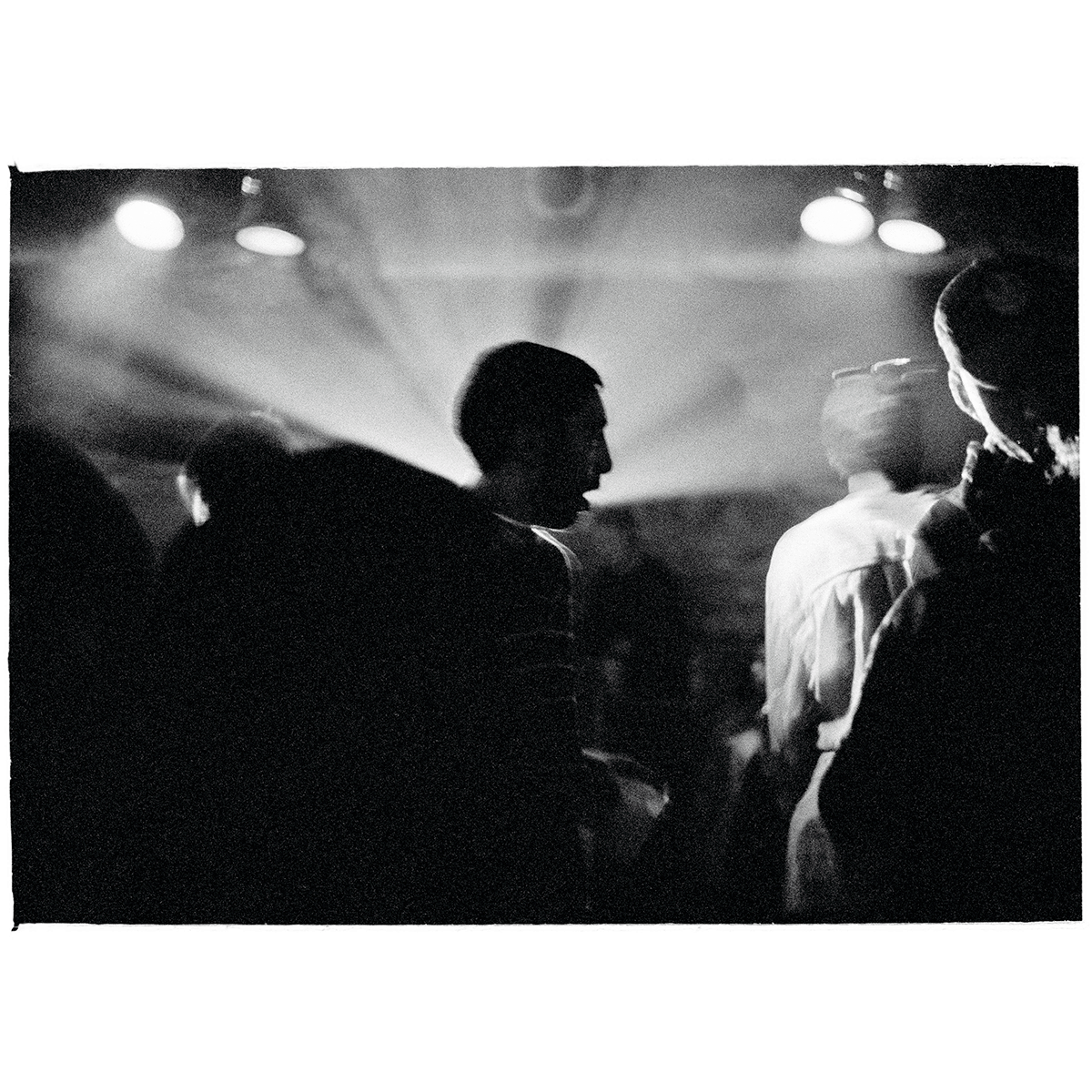
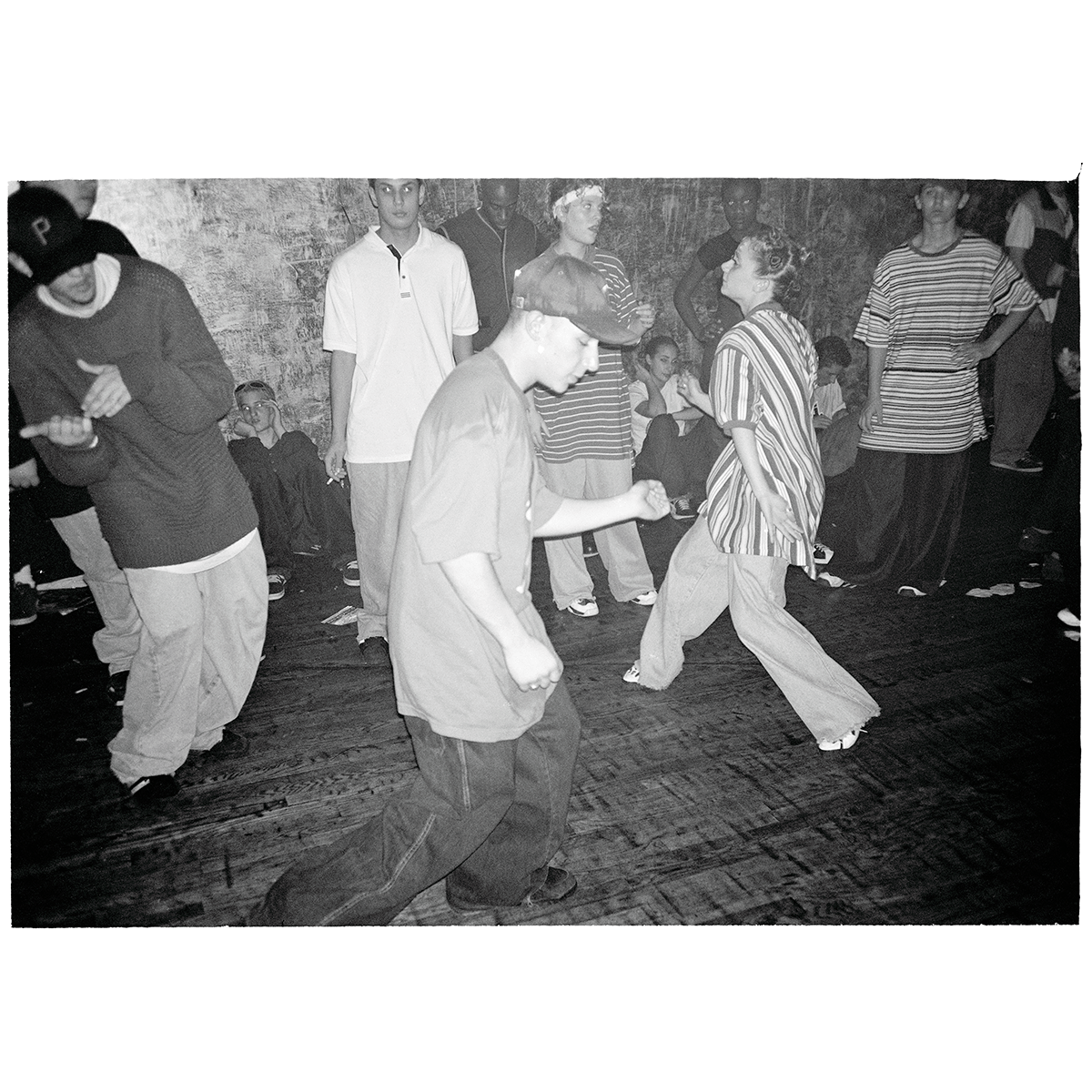
1. DJ Photos - club kid, 1995
2. DJ Photos - club kids, 1995
Auspicious! Do you look back at you older work, because, I mean, we’re talking twenty years ago now. Do you look at your earlier work, AND, how do you think of it in relation to your work now?
Um, my earlier work was…here’s what you can only do, probably only do when you’re in your twenties and you’ve just gotten to New York City, I spent seven years just photographing DJs, obsessively, I would make lists of everybody I had photographed and I would read everything. I’d be like “Oh shit, DJ Shadow is coming to New York two weeks from now,” and I would write it on my calendar and stuff, and it was like an obsessive game. I had to catalog all of these people, and I was going out all the time and just shooting very unselfconsciously and not really thinking so much about where it would go and just really enjoy it. And the best thing about those photographs, the earlier ones are in black and white then I switched to Chrome, but the black and white ones really are my favorite because I was the only photographer. Because in 1994, in New York City, I moved here, I moved to Williamsburg in Brooklyn in 1994 and I thought, “Ohh I’m gonna make friends with all the other photographers,” that’s why I moved to New York and I get here and all the artists are “Uhhhh”… they’re all very guarded in Williamsburg, and I just I wasn’t making friends with those people and the people that I did make friends with were DJs who were throwing these small jungle parties, which kind of became drum and bass parties, and we all had the same tastes, and I got to be a part of it because I was THE photographer, and literally I was THE photographer.
You know everywhere I went I would, I was almost always be the ONE guy who had the camera, you know, which was nice because that was my little niche. So yeah my work back then was different because I was so embedded in the subculture that I really loved, that’s some of my favorite work. It’s, I think it’s tougher when you get older, and you’re an adult and you’ve got to somehow balance making a living and promoting yourself. “Oh you know what, I’m a very good healthcare photographer, which I love shooting” but then also, “I’m a very weird guy who makes THESE photos and who obsesses about Duane Michals too much of the time.” So I find it’s very difficult to relax and just kind of be one thing. I’m too introspective or I’m too caught up in my own head now, whereas before I could fantasize, “Oh someday I’ll be a real artist” or “somebody will see this.” And then you get to the point where you realize that nobody ever, no one ever accidentally got famous. At one point I was so naive, I thought, “Oh this is great I’m having so much fun, someday they’ll discover it and I’ll be famous and this’ll be nice.” Like your weird little kid fantasy you’re having, little kid being, like, 22.
But nobody, that’s nobody…, that’s never happened to anybody. Like Ryan McGinley….Ryan McGinley very smartly in the 90’s was making these little photo books, imagine trying to make a photo book in the 90’s, it’s not like Blurb or something. And he would send them to all the Art Directors, and he was constantly shooting his friends and I’ve read interviews where his friends were like, “Ugh, Ryan would have us do the same thing over and over and over.” So you see this photo of this nude girl who’s running past, like, a hung up Star Wars bed sheet and you’re like, “God, Ryan’s just caught some weird moments” but the his friends are like, “Uhh Ryan I just did that, I just did that!” (10:00) and he was very very smart in getting to where he is. But I don’t think if one were to see his work, they’d ever guess that. So that’s a long, long tangent about fame and how you get to where you want to be as a photographer
I have this book about Duane Michals and it’s really kind of a little biographical photo study about him, but it’s really more about me. And I’m doing another one about Arthur Tress, who I’ve gotten to know very well and that’s really going to be a little photo-biography about him…and so I guess my current work is more about showing my relationships with other people. That’s one thing I know I’m very good at, really getting to know people very well and having these interesting friendships. And I want to show that as a way to encourage other people to “go do this yourself,” you know, go talk to somebody and it’ll probably work out.
What is it that led you to do those two projects, specifically?
With Duane every person I talk to responds, “Oh, I loved Duane Michals in school!” I teach photography as well, you can show him to students and it’s immediately enjoyed and embraced, because it’s just the idea. He almost never even uses a flash, it’s literally a camera, a tripod, and that’s it! And the idea is just recorded by this box that you just have with you, and that’s it. So what are you going to put in front of the box.
And that’s the charm of Duane Michals, so I loved him in school, and then I got into some other people, you know. You start getting into edgy things when you’re younger, like I loved Joel Peter Witkin, who I still love, but you go through that phase where you’re like, “Wow, this is amazing! It’s a monkey on a cross!” And then eventually you get into more subtle things, so I kept coming around in cycles with Duane, and then maybe five years ago I just started really getting into his work again and ordering a lot of his books, finding them used here and there on Amazon and stuff and so that’s what led me back to his work and wanting to connect with him. I’ve met almost everyone I’ve ever wanted to meet. Really! Like Joel Peter Witkin, I took a great one day seminar with him and I got to talk to him for a while. Just everyone I’m interested in I end up finding them.
Arthur Tress… the quick story there is I was at the New York Book Fair about four years ago and I was going through the card table set up with everybody’s books you know fancy books, low-end zines all kinds of stuff and I come to this table and there’s this book there, it says, “Arthur Tress: Skateboarders”, and it’s this square book and I look at it, and I ask the girl who’s like nineteen, and sitting on the other side of the desk, and I say, “Is this THE Arthur Tress?” “How old is he??” And she rolls her eyes to her left, and I look over next to her and there’s this older man sitting next to her! And I say, “Oh, are you Arthur?” And he said, “Oh…yes.” And I said, “Arthur, listen I (I mean I’ve never met him),” I said, “listen I don’t mean to be insulting,” I said, “I just don’t think of this, when I think of your work, I just don’t think of this type of work.” And he said, “Oh do you know my work?” And I said, “Yeah you’re part of the lineage and history of photography! Yes, I know your work.” So we started chatting, and he showed me other books he had made and stuff and he said, “Oh I’m in town for a few days, would you like to go out shooting?” And I’m said, “Yeah! That’d be great.” So he came over to my apartment, signed my Arthur Tress book, we looked at my work and discussed my work. He literally just formed a project that I went on to do, by taking my photos and putting them onto these old comic books that I have because I love comic books. And we made these collage ideas. And then we went out to Coney Island and we shot all day!
So long story short from there, he’s just somebody who, who I stayed very connected to. We obviously understood that we are friends and we both like photography and there’s a quality there and I’m a very easy-going person to kind of be with and be around. And so now we talk on the phone about once a week. I visited him out in California, a few times. Beautiful, he had just moved out of Big Sur, had this beautiful big house in Big Sur, it was amazing. So I’d go out there and we would just spend two hours at the end of the day, from 12 to 2 AM, just spreading prints out all over the floor and editing, or shooting during the day. So in all that time, it was about four years, I just kept taking pictures of him and talking to him so that’s a complete book. So I forget what this question was but I will say that my work really has to do with the thing that I’m good at, which is connecting with people who really interest me and obviously not being a manic fan but being somebody who’s like, “There’s a reason why I enjoy your work and I want to connect with you, the person.” Because life is short and we can do that, it’s exciting. So that’s kind of the gist of a lot of my work now.
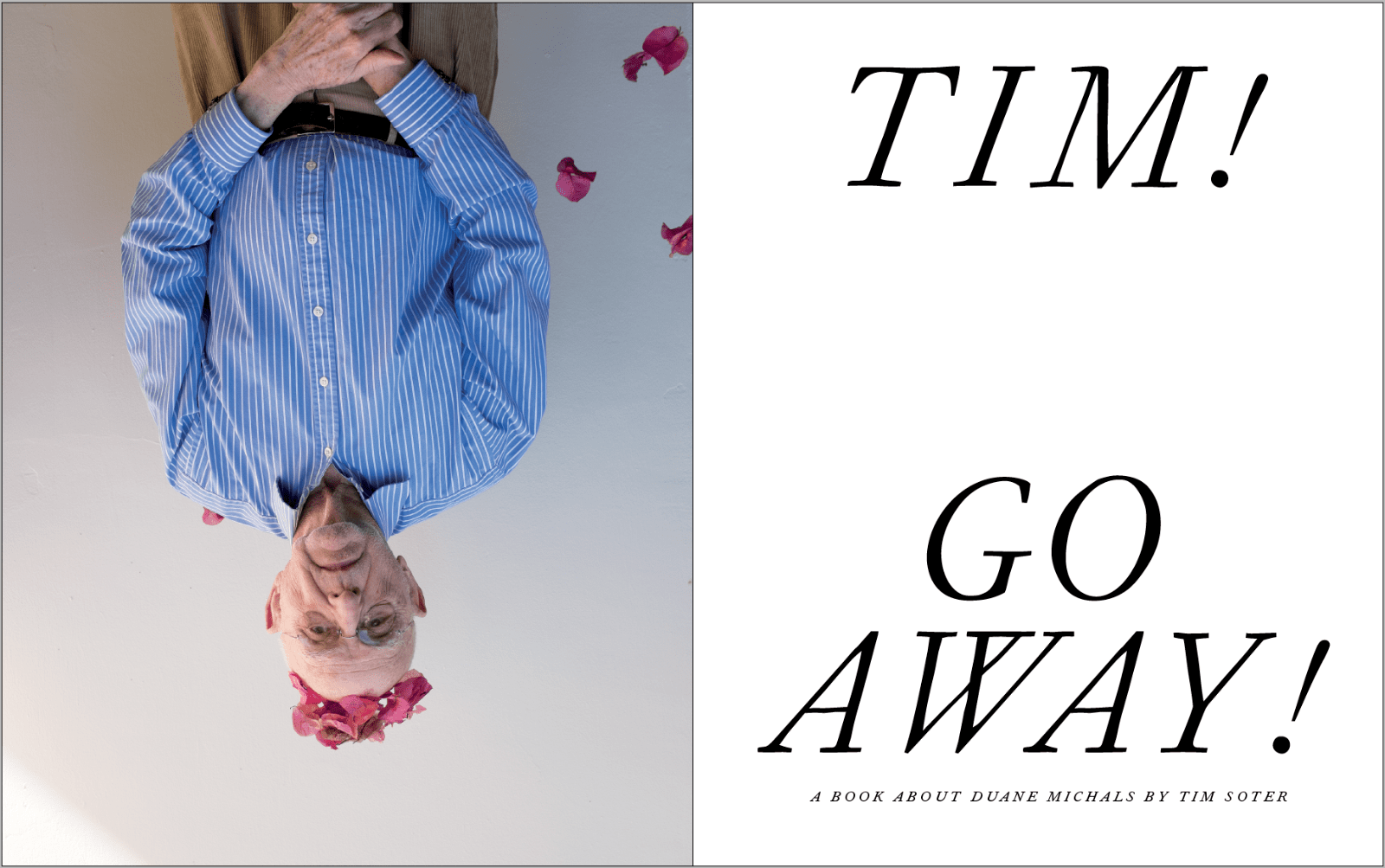
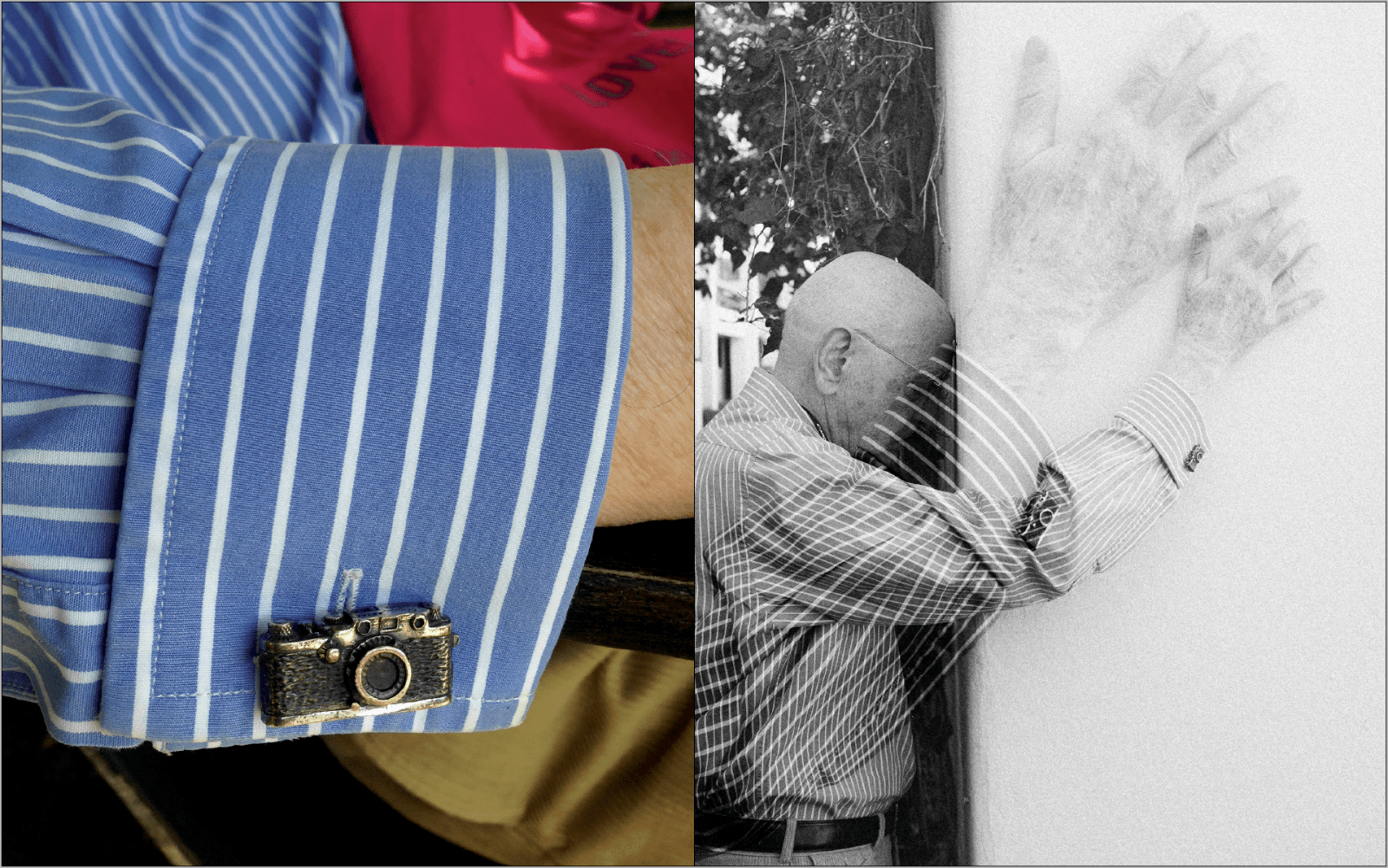

Did you see them as initially as evolving into projects with these two…”mentors” might be the right word?
Mentor is a good, yeah, it’s a good term. And, not, not at all. You know, with the Duane book, the Duane book is called “Tim Go Away!” Because I had written Duane a letter, I hadn’t met him, I had written him a letter and said, “Look you did this wonderful book on Magritte, who was your hero when you were thirty, you traveled to Belgium and you met him and you did a project,” I said, “I really connect with your work and I’d like to come and meet with you, that would mean a lot to me.” And I said, “we’re both from Pennsylvania you know and I said, “I carry this little laminated card,” and it says,
“Doing: you have two choices in life, doing and bullshit, I hate photographers who talk about photographs but never take any, and the only way you’re ever going to grow, two things, one you have to take risks, you have to be able to let go of all your preconceived notions of what photography should be and open yourself to the possibility otherwise you’re going to be spinning your wheels the rest of your life.” That’s his quote! That could be a semester right there.
So you know, I love that and it’s tough to embrace this all the time, but you can apply this to everything, I would say, not just photography. So I write him this letter and he calls me back a few days later and he’s like, “Oh hi, Tim, it’s Duane Michals, actually my brother’s name is Tim that’s a funny coincidence, well would you like to come over, I’m available on this day or this day.” So I call back the number that he’s given me, all right, I’m excited, I mean I’m really excited! It’s like I describe it to people, “if you really liked U2 and you wrote Bono a letter, and Bono called you back and said, ‘Hey it’s Bono, yeah come on over’ and I’m like it’s Bono and you’ve loved U2 for years!” It’s like that. So I call the number back and it rings and rings and rings, and I do this for two days, and this number that he’s given me on the voicemail rings but there’s never an answer, and there’s no answering machine and it’s getting close to Christmas and I’m thinking, “I don’t want this to drag on too long, it’s a lucky break,” so now I’m like, “What the fuck and I going to do, am I going to write him another letter?”
So what I decide to do is, I wrote a postcard, it said, “Hey I’ve called your number a bunch but it rings, there’s no answer didn’t want to bother you but I’m free and I’d like to come over” and I took the subway and I went over to his home and I slipped it in the little letter box without postage and I thought, “Ok I’ve done it now. He’s either going to think I’m crazy and am stalking him, or he’s just going to think it was the easier way to get in touch with him. So he ended up calling me back and he said, “Oh yes, I’m sorry I had phone problems, uh why don’t you come over in two days.” So I met with him, we sat down for almost two hours, I got to ask him all the questions I wanted to know like, “What do you think happens when we die?”
Hahahahha!
You know of course Duane, he’s happy to talk about that. And then when it was almost done he said, “what time is it?”
“Oh it’s 4:45”
“Oh you’ve gotta go, you’ve gotta go.”
Hahahahhaha!
And it’s like, okay, I had two or three books with me and I said, “Would you just mind signing these books?”
“No of course.” And the first book, he signs, “Tim! Go Away!” So when I had that in a dummy copy, that page, people would be reading the book and they’d get to that and they’d laugh and I’d ask, “what are you laughing at?” And they’d say, “Well, Tim go away!” And so that’s why I made the book that title because…
It fits!
Yeah, and people liked it and it’s that sense of humor.
Had you done books before these?
No! So it’s pretty cool, I think everybody’s in the same learning curve and they’re really figuring it out, “Ohhh, this takes a few months.” This takes a long time to really figure it out. I think if you really do it, self-publish a book, you could go teach a course once it’s done. Paper choices and working with a printer, and really trying to communicate and laying it out and stuff. But it was exciting. At first there was a point where I had put it all together, and I thought, “Ugh, is this anything?” You know like, “what is this?!” First of all I NEVER wanted to share my letters to Duane with anyone. I just scanned them in because I’m an obsessive German-blooded photographer and I save one of everything…
Hahahhaha!
I have OCD too, to some degree. You know in a funny way. But then I had these things, and I made this book and then at one point I’m like, “What is this?! Is there even enough stuff here? What is this?” So I called up Arthur, because Arthur and I were friends at that point. But Duane was still this guy who was over there who I had talked to him a few times but we weren’t friends. And I asked Arthur, “What is this thing?” Arthur is incredibly smart and he said, “You know, you don’t like it when things get messy. Really loosen up and have some fun with it and move things around.” He gave me a lot of good advice and it got me over a little bit of a hump. And then I pushed on with it.

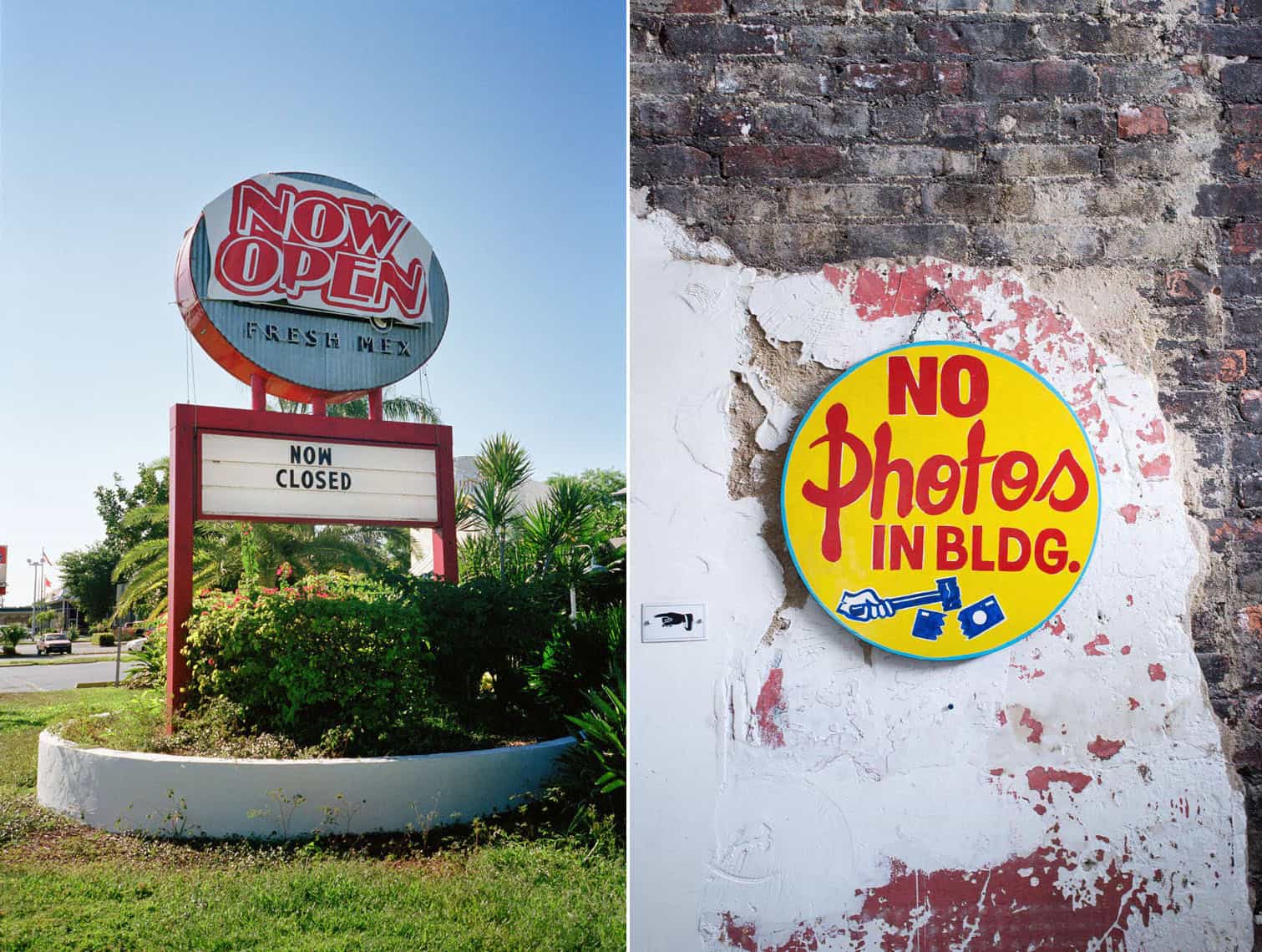
I mean, when is it due to be released? (Editor’s Note: the first edition came out in Feb and is SOLD OUT, a second expanded edition is being printed now.)
It’s currently at the stage where I have to approve the final proof. I’m getting sent the physical hardcover to see how to hard cover prints as an image wrap. So realistically in like a month. It’s going to be an edition of fifty books. Each one will have a tipped-in page out of one of my Duane Michals books that I have taken apart, put my stamp on, and so each book will be unique. That addition really gets into the tight circle of obsession, so yeah, so it’ll be interesting. But it’s very interesting, all these photo-books, how do you price them, how do you set a price point. You know, I don’t think anybody’s making any money off of this. That wasn’t my goal, but you know you still ask, “how do I price this so that I break even, that would be nice.” But I think it’ll be exciting when I finally get a hard copy and think to myself, “Oh this looks like all the other books on my Photo-book library. You know, blends right in, and I made that book,” you know, it’ll be nice.
And you said you teach as well?
I teach sometimes at FIT as an adjunct professor. I’ve been teaching a Business of Photography course, which is good, because every time I tell that to photographers, they say, “Ohh I could use that course,” or “wow we never had that course.” And I reply, “I never had that course, either!” So it’s things like how do you send an invoice, how do you communicate with a photo editor, you know oftentimes I’ll come in and I’ll say, “Here’s a call I just got, here’s the whole job from the time I got the call to the time I gave them the completed files, here’s everything that happens.” I’ll read them all, I’ll read them the email correspondence, everything. I’ll leave out everybody’s names, but I will be very honest. Just like if it was going off the rails a little bit, or the client was doing something that wasn’t great, or there was a bad work for hire contract, or all those things, I’ll just tell them because it’s nice to learn anecdotally and see what’s really going on. So that’s kind of the gist of that class.
Do you….well I assume you enjoy teaching?
Yeah yeah, it’s good. I love the Fashion Institute of Technology, the professors there are really great. A lot of them are good friends of mine. And yeah, it’s really nice. However being an adjunct professor really doesn’t pay well enough.
HA!
It really doesn’t and I mean, this is a universal thing. There are so many people who are up in arms. You could not make a living being an adjunct professor in New York City. You know, I don’t even really think about what the check is, you know, it just goes into my direct deposit and I think of it as like…lunch money! Or something like that. It’s really not enough money, so at some point, you know, it gets frustrating because it’s a skill, it’s a real skill, it’s fifteen years of me figuring out how to still be a working photographer in the city. And teaching that to people is a skill that should pay a lot better than it does. And it’s not that school, I mean it is that school, but it’s most schools.
It’s the industry.
Yeah, exactly. It’s a problem that needs to be addressed in a bigger, bigger way. But I like teaching because I think I certainly know what my weaknesses are, and I know what my strengths are. I know that I’m a good communicator and a good teacher. I like doing that, and I think it’s important. I enjoy it.
What would you consider your weaknesses?
My weaknesses…that is a good one. (sigh)…my weaknesses would be…it’s very difficult for me to focus. And it’s difficult for me to figure out what happens when something’s done. I can get everything there, you know 85% of the way, and then I start doing this loop to keep myself from not going the full, full way. I’m amazed at how people get photo shows or their books published, and things like that. I don’t know what it is, it’s a creative person thing. You know I think a lot of people start off thinking, “Oh I can do all this” but nobody likes to do a lot of promotion or really getting their stuff out there.
Right.
I wish that part were easier, because I could do all that other stuff, but I just don’t know at the end, and you have to make it up, you know, how do I promote this thing, how do I get people to know that “Tim! Go Away!” is actually a photobook that really is NOT like any other photography book. I really, really believe in this book, because I’m a good judge of my work. I know when something is like, “Oh that’s pretty good.” It’s good. It’s a good book. How do I get it out there? I just want people to read it. I want to see what people think of it. It’s not about making money or anything like that.
It gets me thinking: having had a career this long, at this particular time, what kind of changes have you seen in the industry?
I think as a working photographer, it’s…ooooh, there’s a lot of competition, there’s a lot of competition on a lot of different levels. So now, clients have smaller budgets. Obviously we know a lot of magazines have kind of….you know….
[puts fingers to lips, blows on them while flinging fingers into the air]
Yeahhh exactly. Hahahhaha. If you can write that gesture. Yeah.
TA DA! AGUSTIN, INSERT KEYSER SOZE GIF.

Sorry, we couldn't resist – Agustin
Hahahaha, yes exactly. So yeah, budgets are really going down. And you have to be a better negotiator. And you have to know when to say, like, “I’m sorry, I can’t do it for that.” Or, “I’d like to do this job, but I cannot sign a work-for-hire.” You know, I’ll ask clients, “Well, why do you need the copyright for this?” Now, the frustrating thing is the middle, the photo editor, or the job assigner. That’s the person I’m dealing with, who I usually have empathy for. Because it’s literally somebody who came in who’s a lawyer, way up at the top, and that person came in and they said, “You know what? I don’t know why we’ve been giving away all this re-use for our other publications. Just have him sign this thing, and then we own everything etcetera etcetera. Just have him do that.” So that guy comes in, tells that to the CEO, boom it’s done. Now I’m talking to the photo editor who has to say, “Well we have this contract blah blah blah.” They slide it over to me. I see it. It’s work-for-hire, it says they own it in perpetuity, it says things like, “We have the ability to resell your photograph to whoever we want.” You know, I see a lot more contracts like that. You want to say to the photo editor, “You know, you chose me for a reason. You know that my work really does connect well to what you’re trying to do. We’re a good match. I don’t want to sign this.” You know, the photo editor, unfortunately, doesn’t have the leverage to go back and say, “Look this guy’s really good for this particular project; I want to use him. Let’s cross out some of this whatever.” The photo editor has been told, “You’ve have to get him to sign that, and if not, get the person who’s right behind him because that person’s going to sign it.” The photo editor has no leverage because the photo editors, their jobs are just as at risk as the photographers, right now. You know, they don’t see the long term stability in their jobs. So that’s kind of what I feel is one of the more frustrating points of where photography is at.
Have you made adjustments creatively with the explosion of professionals that have come along the past ten years?
Yes, I think finding a niche is really important. I somehow got started photographing some healthcare campaigns, which I really like shooting. You know sometimes I shoot advertorial events, and I don’t mind shooting events. Everybody there knows why they’re there. They don’t mind that you’re taking their picture. I have a drink at the end, and I go home and it’s fine, you know, it’s all done, and then I can get back to whatever weirdo project I’m working on. You know, it’s great. But with the healthcare things, obviously there’s a lot more money there. That money can sustain me for a longer period of time, and I can take a chunk of that money and put it on a book project or things like that. And for me, the healthcare things are like doing a bit of directing. I get in there, oftentimes I work with real people, like a real doctor and patient. And it’s my job to get them into a good mood where I get a real genuine moment. I like relaxing people. I like making them laugh. It feels easy for me to do that because I’m happy I’m there! Somebody’s paying me to take pictures! It’s great, it’s just like what I wanted to do, right out of school! These jobs pay well and I go in in a good mood and it’s just great. I create that atmosphere because that’s how I feel and it’s just genuine and I like those jobs. So that’s how I’ve adjusted, I’m trying to get jobs that, as it turns out, I’m having fewer jobs than I would have had ten years ago, but they’re paying a lot better. So that’s where the balance shifted. I’m not shooting as many editorial jobs. Ten years ago I was shooting a lot for Rolling Stone, which I really enjoyed, I love shooting bands, and I shot over forty portraits for them, which was great! But that assigning shifted and now I’d rather have a job where it’s a healthcare campaign that maybe nobody knows I took, unless I promote it, and while it doesn’t have some sort of cool cachet I still think, “That okay!” Because I can wake up tomorrow and have a cortado and work on my photos. There’s no pressure because I had a good healthcare job. That’s kind of the shift for me.
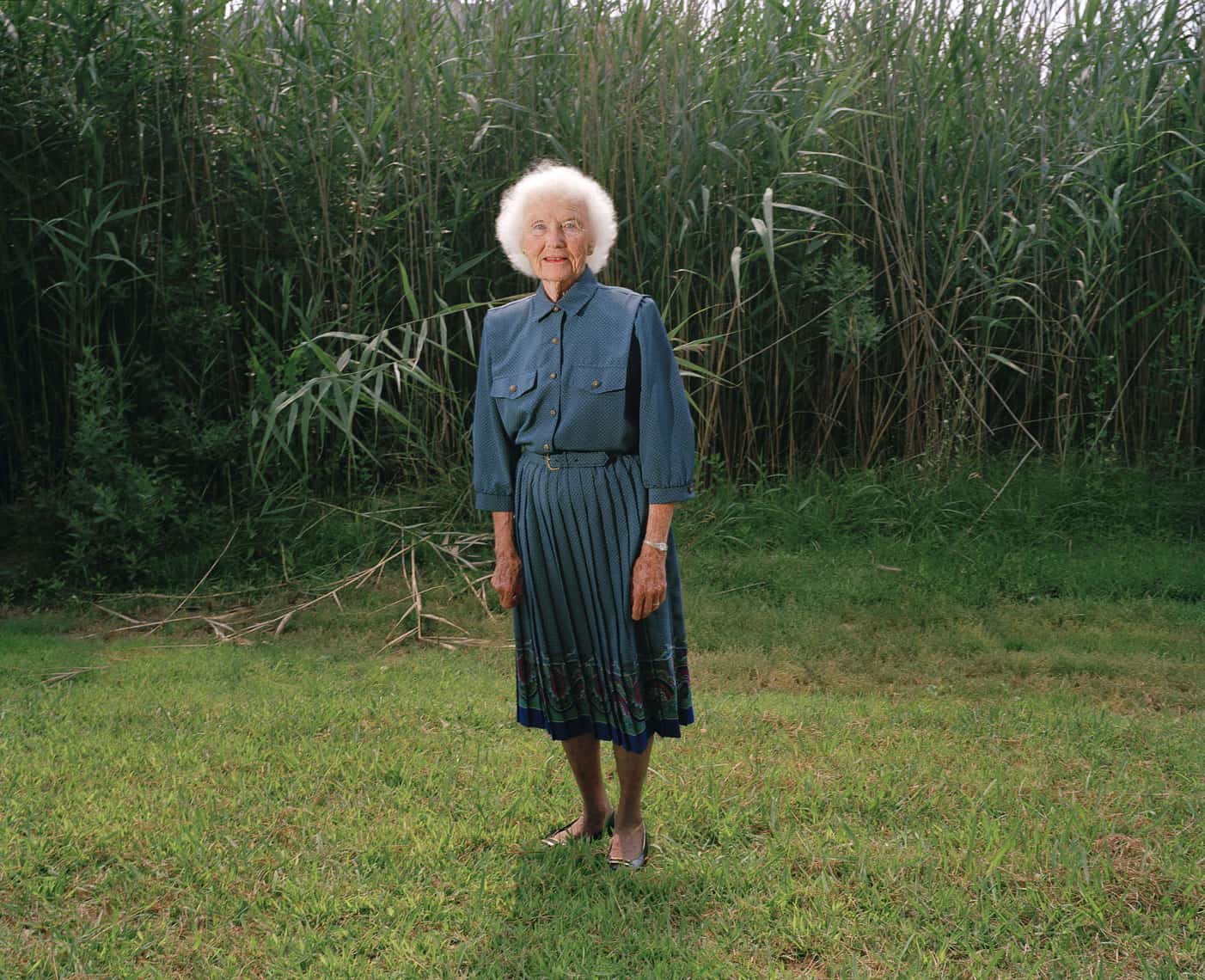
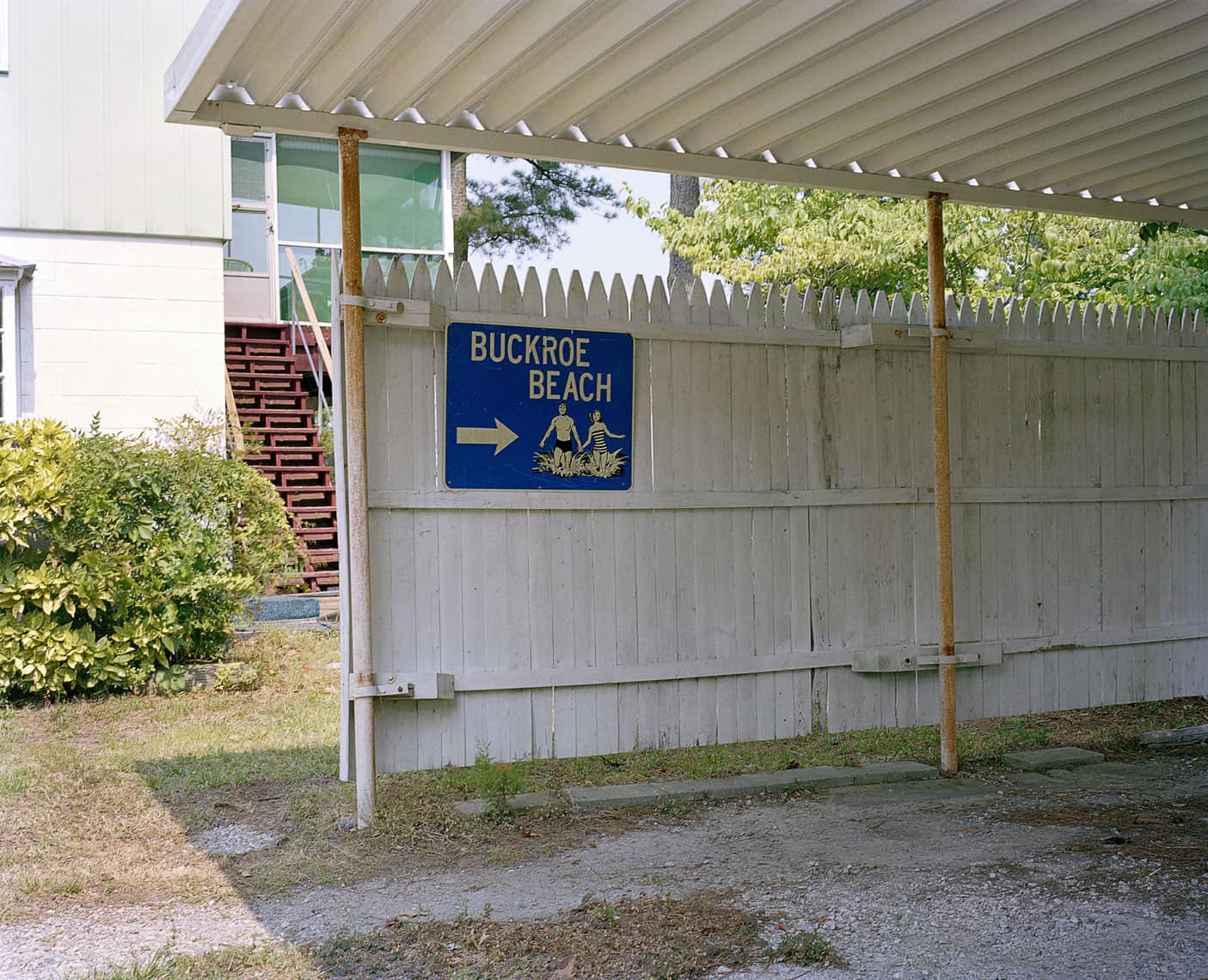
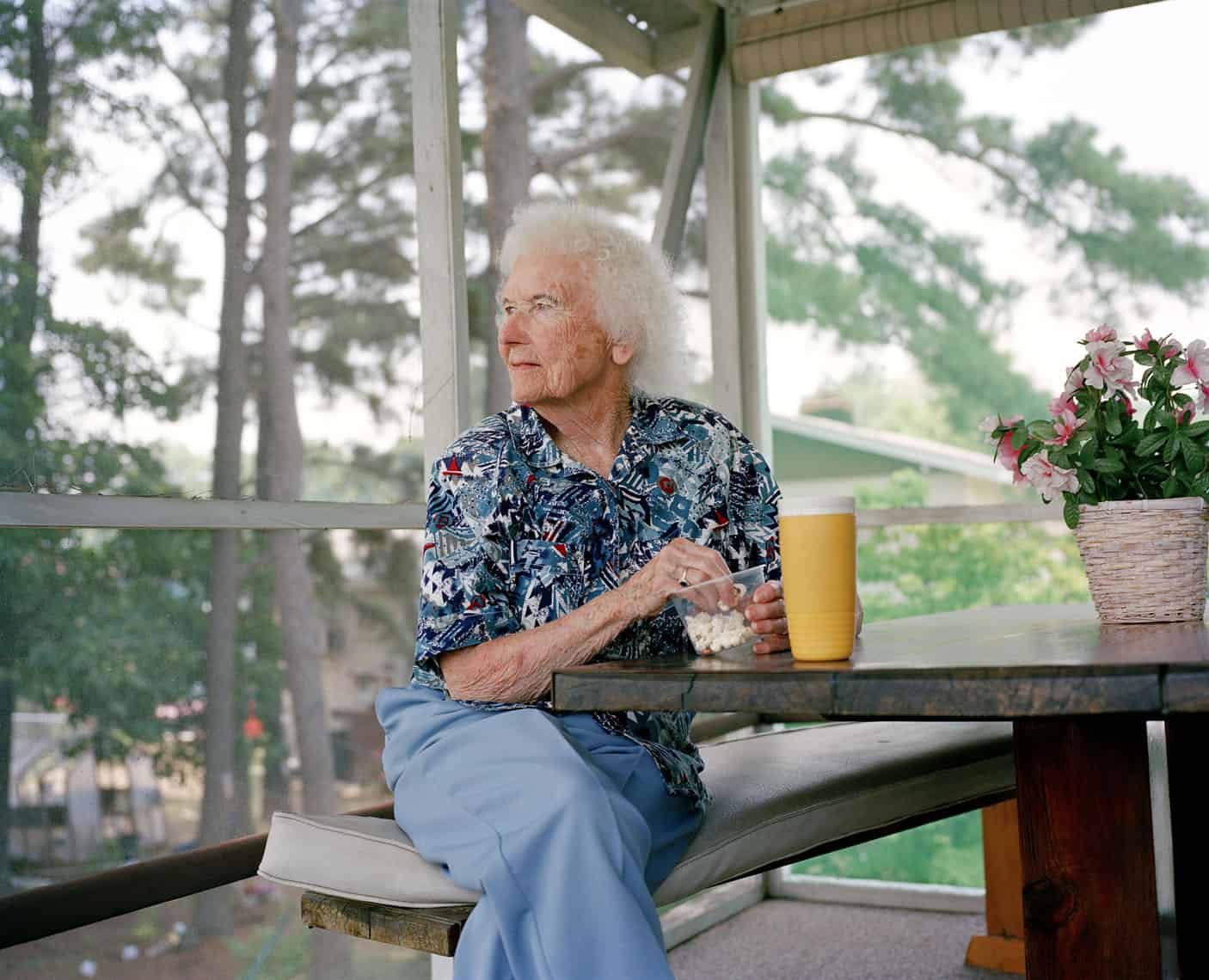
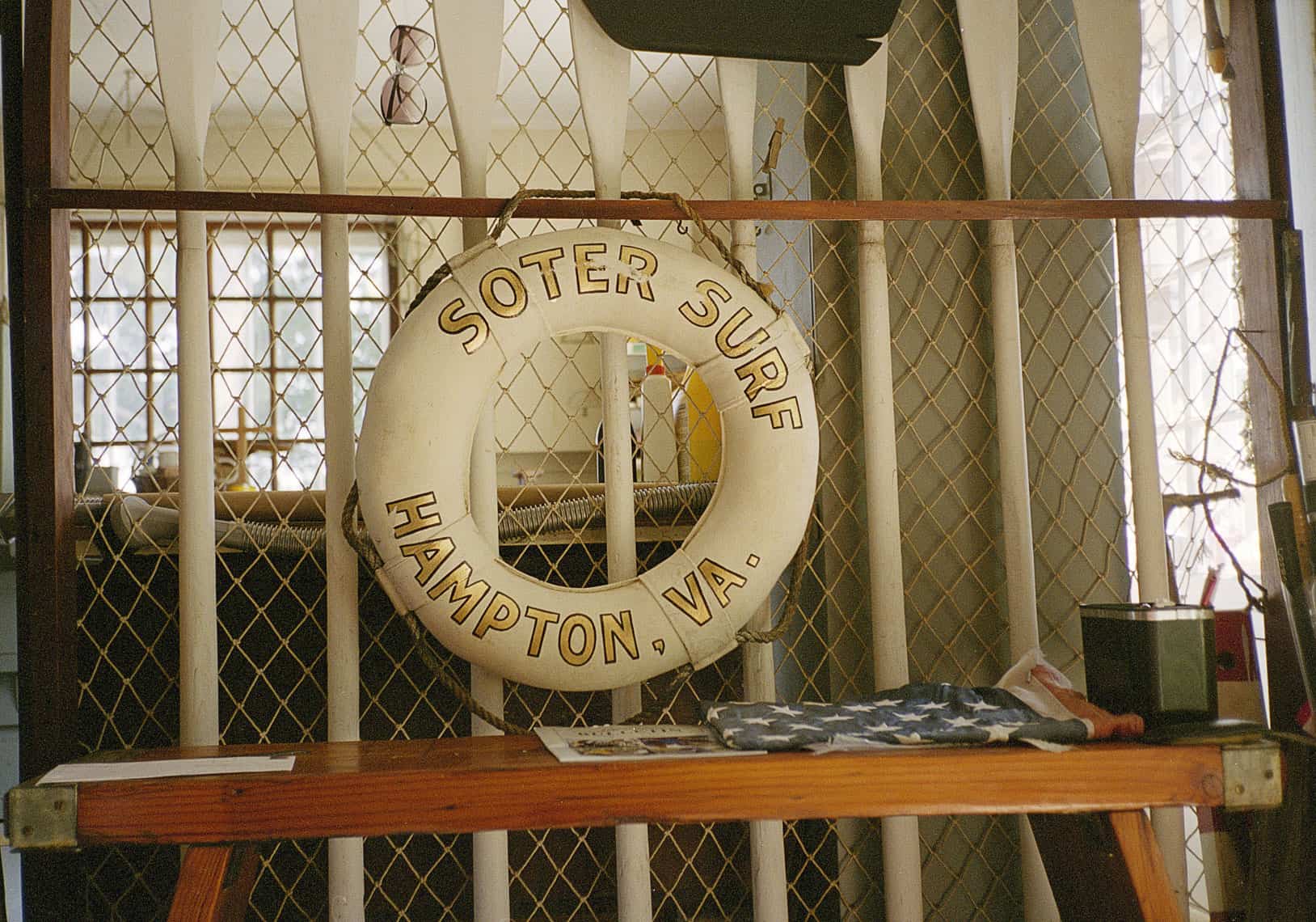
Granny - Tim Soter
Where did you see your career going when you were starting?
When I was starting, I will say this about the university that I went to, no one told me I could assist. I literally didn’t know photographers had assistants. So when I moved to New York City, I just started going through the back of the Village Voice or The New York Times, looking for full-time jobs I could do that was photography based. So, I ended up being a photo editor for a little while. Maybe ’96 to 2001, somewhere around there. And that was really helpful because I got to see what it was like to be a photo editor and assign work. The last photo editor job that I had was at FHM Magazine, (the US edition folded a few years ago). But that was in the heyday of “lads” magazines, FHM vs. Maxim, you know and then Stuff came out. And then internet content was a big thing. And the internet’s like, “We don’t need this,” pushed all that aside. Anyway that was the last photo editor position I held. I remember looking at physical portfolios, every photographer would drop these heavy things off, leather-bound, some still do, but that was the thing to do then. You know I would look at them, and I would either say, “Ugh my work is better than this.” Like, I’m better than this book. OR I would look at them and think, “Oh my god, this book looks awesome. I want to get to this level, like I want to be as good as this person.”
One of them was Michael Schmelling. Michael Schmelling, he’s out in LA now. He’s done a bunch of ad campaigns, editorial work, he makes really nice fine art photo books, he’s had shows, he was the first guy, when he brought his portfolio in, he had an environmental portrait on one side, and an environment next to it. I remember looking at his book and thinking, “Oh my god, you can do that?” Which sounds very passé now, but back then people weren’t really doing that. You know it would be the same portrait, portrait, portrait, but his book looked really like a cool magazine or something. And I loved it. I was really inspired by his book, so I left FHM, and I decided I’ll take my little savings and I’ll stop being a photo editor, and I’ll start right back at the bottom. Like the Drake song! Hahahaha!
Hahahhaha!
And I’ll work back up, and I’ll just be a photographer full-time. And I was shooting all the time while I was at FHM, I was shooting at night or whenever I could, I was certainly shooting for that magazine, but I realized I couldn’t do both at the same time and really be a photographer. So I left, and I started at the bottom. I assisted maybe two or three times. I was a terrible assistant. Because I was like 29 or 30, and I was already a photographer, so I’d be on the set, and I’d want to learn things. And I’d want to learn how to use, you know, ProPhoto Packs and then at some point in the shoot, somebody would yell, “Tim!” and I’d be spacing out. I’d never done it before, and it wasn’t the right time for me. So, I ended up being a photographer and getting in touch with a lot of photo editors that I know, now trying to convince them that I really was a photographer. And it just kind of eventually all worked out to where it is now.
Were there people you looked up as you were just starting?
Yeah, because it was….this is the thing: the internet was around, this is 2000, 2001 but it wasn’t like it is now. And in that time period, the photography world and the photography shooters were shooting for magazines – it was finite. You’d obsessively pick up a magazine that you wanted to shoot for, you’d turn it sideways and you’d go through, you’d read everybody’s credits. And it was Kareem Black or Michael Schmelling or, I’m trying to think of a bunch of other names, and I’d think, “Oh! It’s that guy!” or you know, whoever it was. And you either personally knew those people, or you at least knew their name and could associate it with their work. I used to play that game with my roommate at the time. We’d get the New York Times Magazine, we’d hold it up, we’d say to each other, “All right, who do you think did this cover?” You know and it was great. Or we’d go to the inside, “Oh that’s Jeff Mermelstein; I see that right away; I love it. It’s either going to be him or Mark Peterson.” That’s who’s covering their reportage; I love them both. So it was a very finite world.
Whereas now, if I were to open up a magazine, I wouldn’t know them, obviously, because there’s a whole new school of people that have come up…
Constantly!
Constantly! You can’t even say, “Oh it’s a new generation.” There’s no generation; it’s every year. But also because maybe somebody will do something for that magazine, and then they won’t do anything again for that magazine. It’s not a lineage anymore. I felt like I was a part of a lineage before, and then the internet came along, and the lineage… There was a time, where I could think, Duane Michals -> Arthur Tress ->me: this tiny lineage. Now it just gets fragmented and splintered and there’s not really a feeling of a lineage. And I’m not bashing “Now” or bashing the internet. But it’s literally just the truth. There’s not even another way of thinking about it, that’s literally what happened. You know, that’s the way it is.
Do you engage with a lot of other photographers, at this point?
Yes. And that was something I never thought would happen. When I left FHM and was going out to be a photographer full-time, for the first time, I just thought, “we’re all going for the same jobs, we’re not going to hang out or anything.” They’re the competition. But I found that it was actually the opposite. The photographers, you know the guys that I already mentioned and other people, they were all pretty cool and friendly. Because if they saw that you were a working photographer who’s really trying, they knew your struggle, they’re doing the same shit, you really had so much in common that how could you not embrace that person and all be a part of the same world. So I found that yeah, a lot of my friends were and are photographers. Just like, currently, Chris Buck, I mean I can’t claim him as a close friend because Chris is off doing a ton of things, you know, but when I see him, I’m excited and Chris is a friend of mine and I really admire him, he’s a great working photographer. Andrew Hetherington, super nice, super accessible, generous person, he’s a good friend of mine, and a working photographer. And there are several, several more. But it’s, yeah, it’s not like I thought it would be. It’s a good community. You know I’m very pleasantly surprised by the way it is.
When you think about your community, do they come off as a like-minded, similar aesthetic, group of people?
Oh yeah…yes, to some degree. But then I think that’s because I sought them out. Going way back to the relationship thing, I remember around the FHM time, like 2000, 2001, my roommate at the time was the photo director at Blender magazine. Great magazine, they had tons of money, Felix Dennis was like, “It’s my money, all in, we’re gonna do whatever we want.”
It was fun! That was like the music one right?
Yes, exactly. So she was over there, and she was working with Chris Buck a bunch. And I loved Chris’ work, and again I’m just kind of just getting started. I told her, “I’d really like to meet Chris at some point.” So, all three of went out to lunch. It was just great. Just really nice, first time I had met him, and it was really sincere. And we ended up doing a print swap, I was super excited, he had this great site of all these people I loved. So he gave me a print of David Cronenberg, my favorite director. It was a really awesome image. It was 11X14 and I asked him, “Do you happen to have a larger one because I really wanted to live with it. I know I’m such a pain in the ass. I’ll pay for it or whatever, I just want a bigger one.” Chris goes, “Oh you know what, I already have this print made, and it’s already printed, and can give you that one. I just happen to have a nice print of this. If you want this one, that’s fine.” And he chose a print of mine, which was this overturned car of a car accident that looked like it had just happened, it’s very strange, set in this serene setting, it’s a very strange environment. So we swap, and I love the print and it’s great. And just this year, Chris called me up and said, “Oh I’m printing a bunch of portraits, scanning them in, printing these beautiful digital prints for this portrait show I’m having, and I’ve got a really large, I think it’s 20×24, might be a little bigger, print of David Cronenberg for you, I remember you wanted a bigger one.” Now he’s remembering this from over ten years ago, and he’s so nice. “Oh I have a bigger one for you if you want to come and get it.” Wonderful.
And it was great, but it all came about again because I said, “I want to meet that guy, you know, I really connect with his work.” And so now we’re casual friends. And he’s this super-nice guy, and I get to talk to him as a peer. Same with Andrew. With Andrew Heatherington, I remember thinking, “Oh this guy’s really doing it,” that’s probably around the same time, like ten years ago, somewhere in that time frame. When everyone was going to his blog to see what was going on and what shows were happening in New York City. He figured it out, he’s very smart. But also, I think a lot of people were probably coming to him, you know, trying to be like, rub his shoulder hoping some of that…
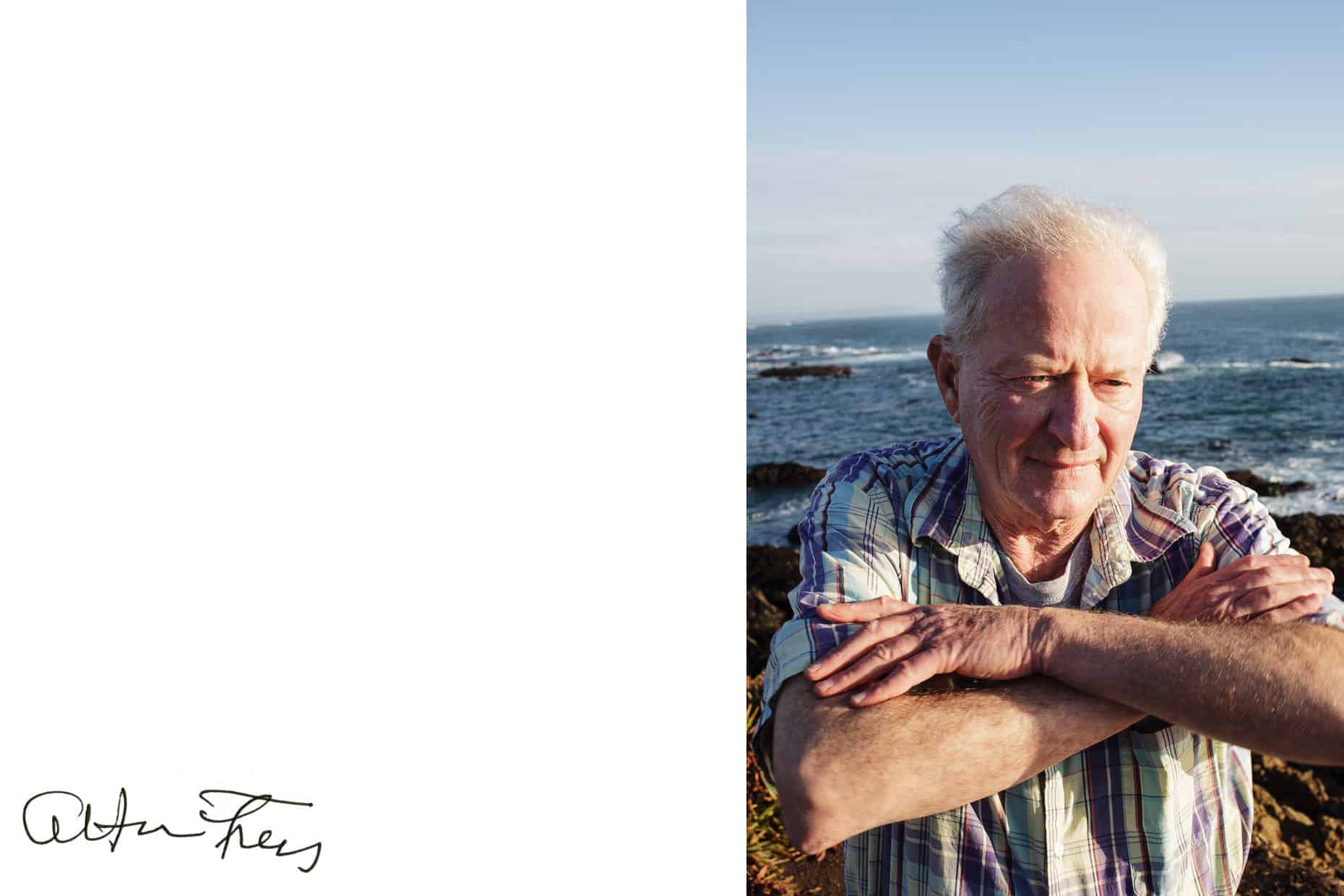
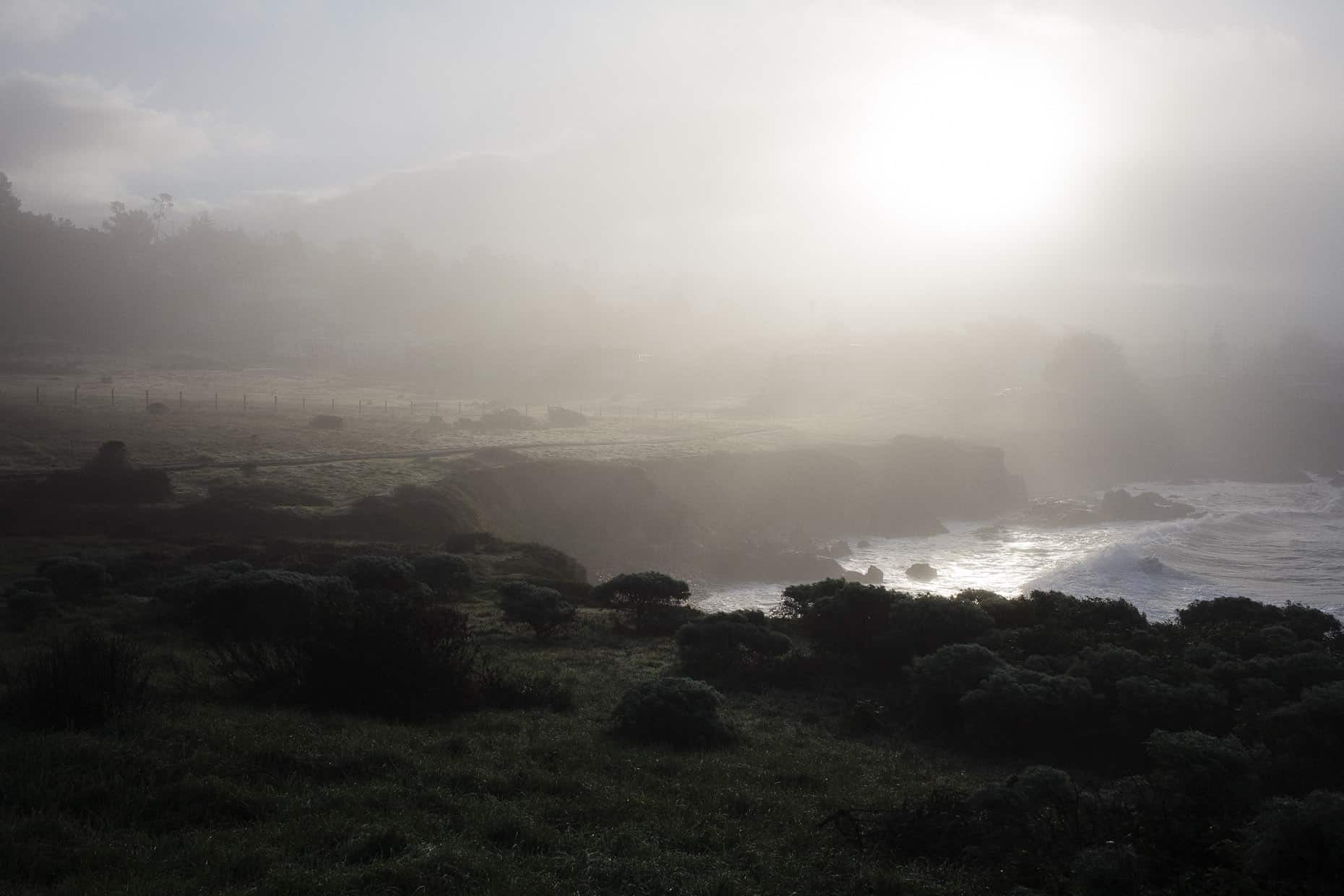
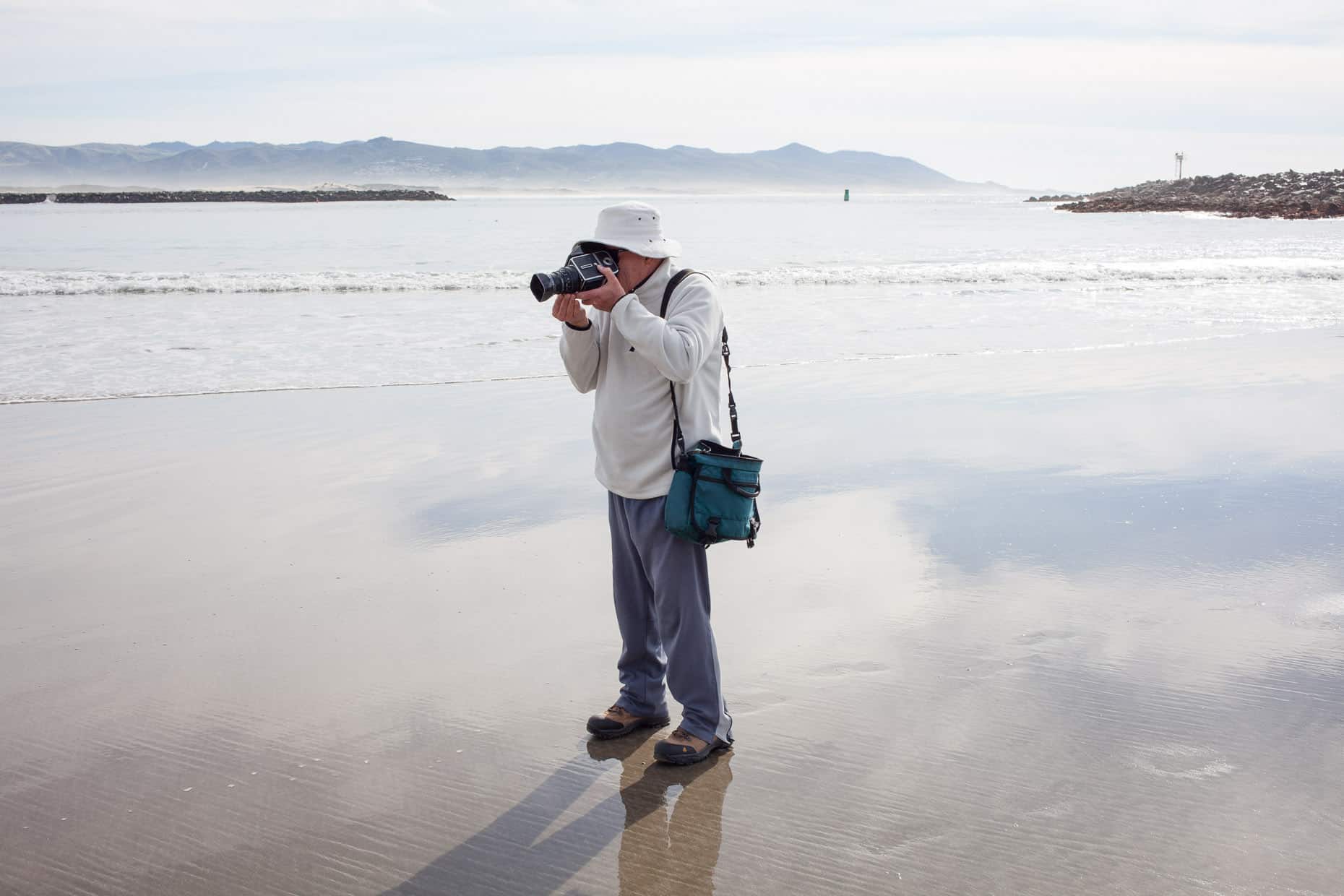
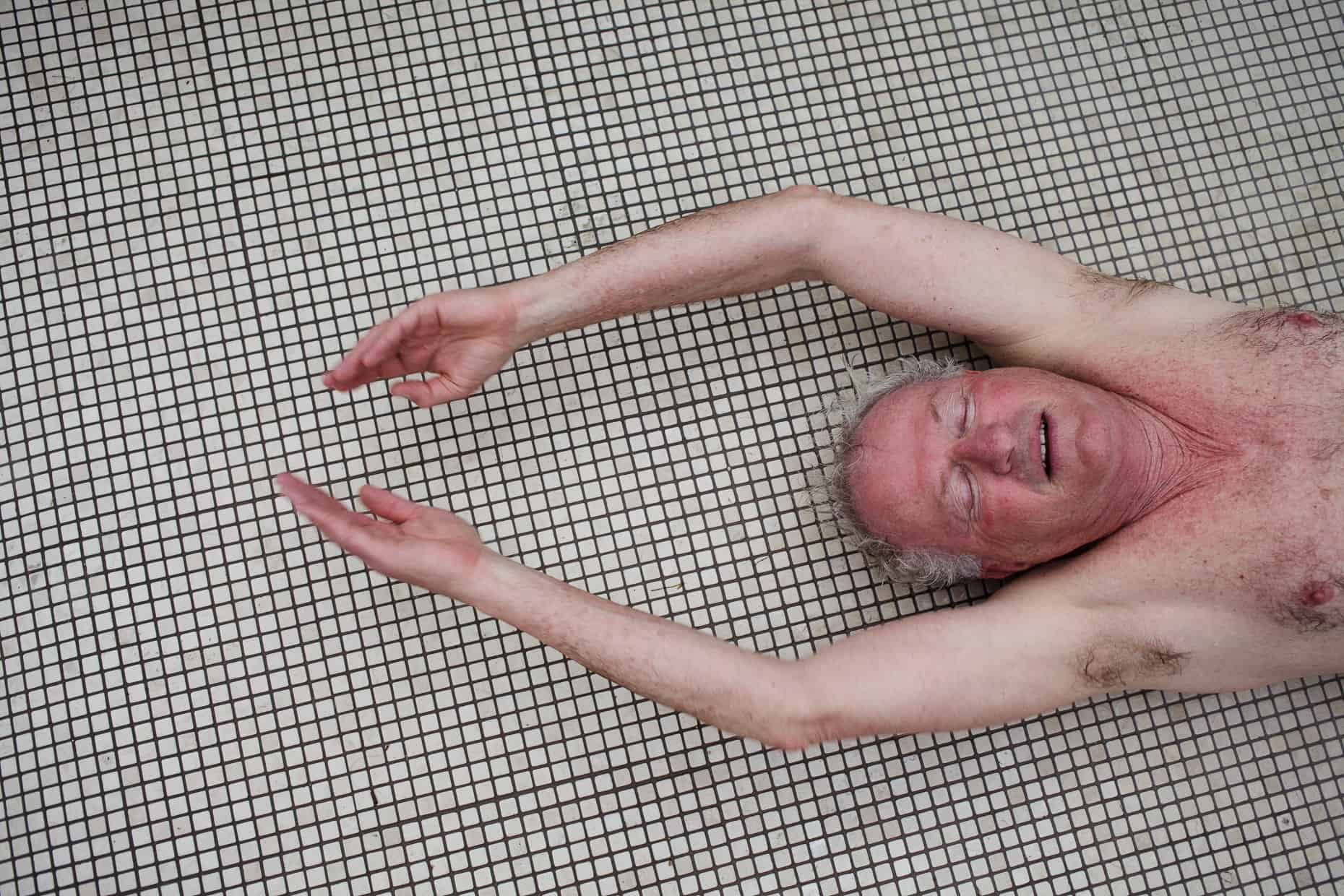
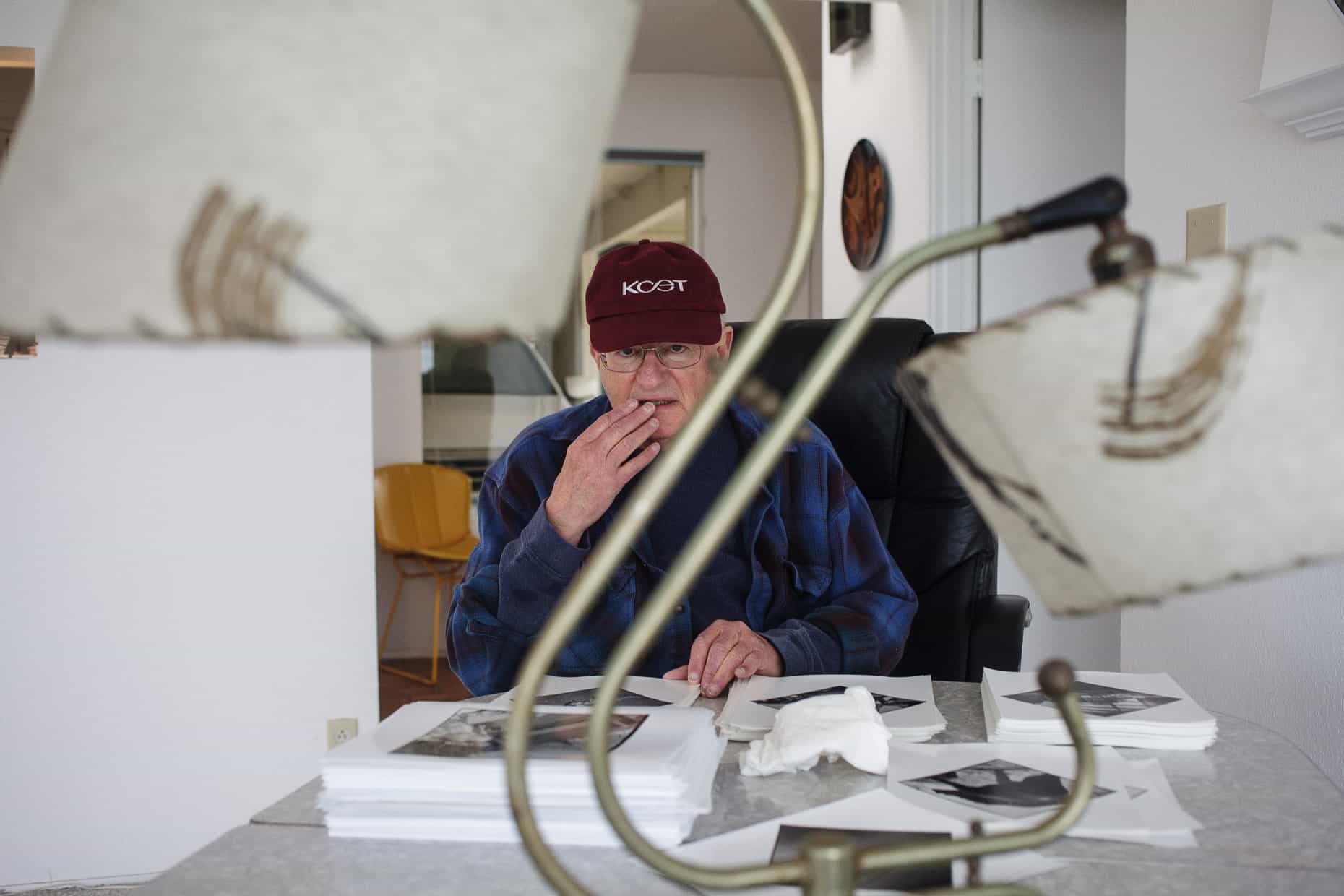
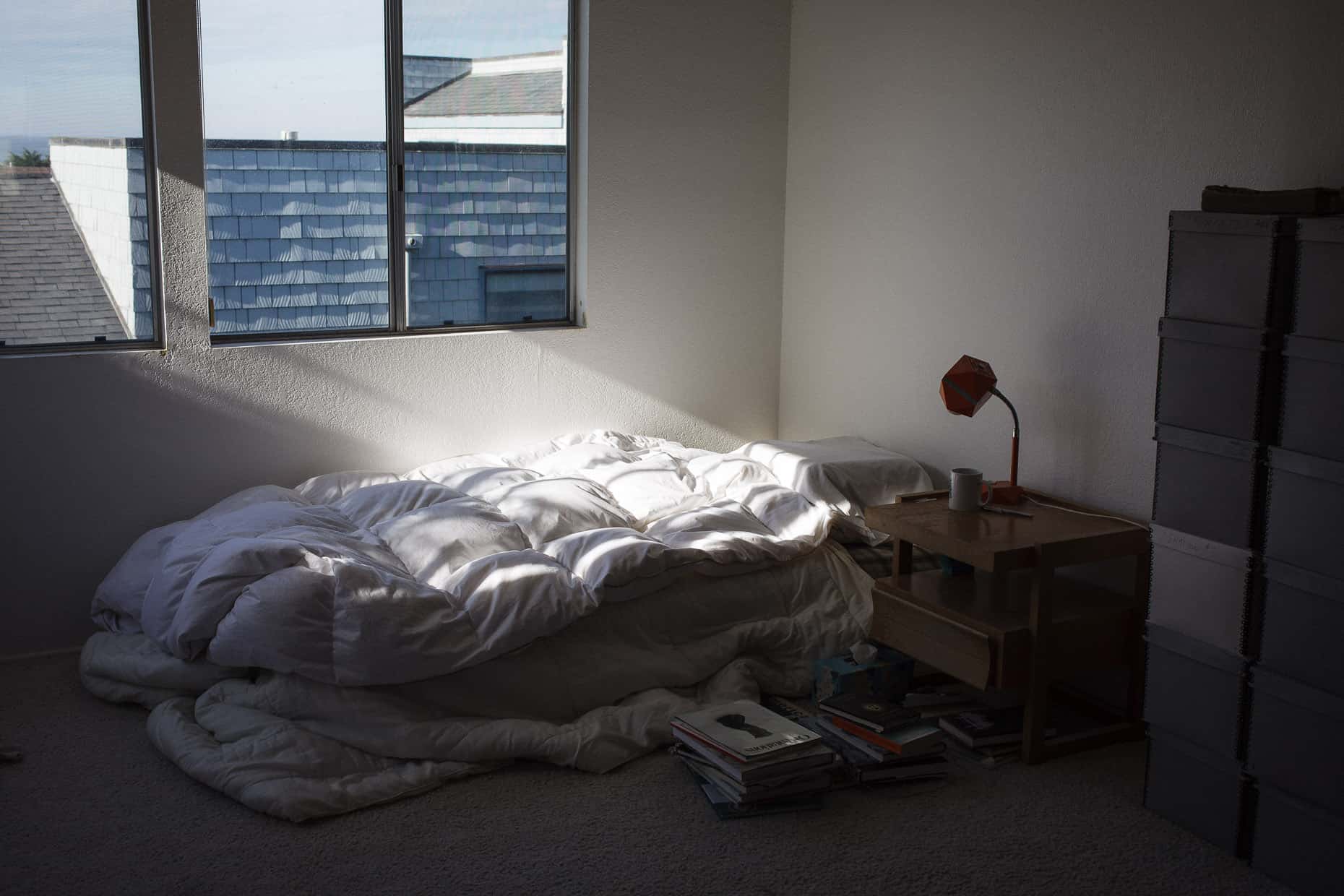
Rubs off!
Yeah exactly. But I met him at about that time, and we had a few mutual friends, and we just kind of stayed in touch.
I think he got to the point where he realized, “This guy’s alright. You know, this guy’s alright, he shoots something similar, I mean our aesthetic is kind of similar.” So yeah, so that’s how that worked out. But it’s never an accident. I think “I like that person, and I want to be next to that person and see what’s going on.” Life is short; those relationships are great. I pay a ton of rent to live in New York City! I don’t have to be in Iowa, no offense to Iowa, but I don’t have to be in Iowa and wonder, “Oh God, I just wonder what that person’s like, maybe we’d have a good conversation.” I can just call them and take the subway and go meet up with them. So that’s how I’ve met them. That was the answer.
Yeah, no totally. The questions are really immaterial is what it comes down to. We just like people talking.
Sure! It’s a starting off point!
Here’s one we ask of all our interviewees: Which do you prefer, the process or the result?
Ok, I’m going to give a very….I’m going to give an answer, but I’m going to use Duane’s answer.
That’s great, however you want to answer it.
Ok good, so I was out to dinner with Duane about two months ago, and I said, “Duane, I really have to tell you something, I have to be honest. There are a lot of times where I think, Why should I do photography at all? There are millions of images; people look at thousands of images a day. Why should I be contributing to that? Truly, what is the point of me even making photographs?” And I said, “Sometimes, beyond all that, I wonder what is the point of really doing anything.” And it’s true, and if you – this is going to be read, and somebody is going to assign tone on to it, so I’ll say it’s not as dire as it sounds! But it is where I’m at in life, I’m really thinking, what is the purpose, why do anything.
In terms of creation? The creation of art or just anything?
I would say in terms of creating photographs because you think, well who’s the audience? You know, we’re just flooding the market. What’s the point. If it’s my own ego that says, “Well the world doesn’t have Tim Soter photographs,” that’s not a good enough answer. That’s just your ego. I’m smart enough to know that’s not a good enough answer. But then sometimes I take it farther, to “why do anything. What is the purpose?” So then Duane came back with this answer, he came back with a really really good response. He came back with a response where he wasn’t trying to be clever, or think of something I would write down. It rolled off his tongue as if he truly lives it and believes it. And he said, “The significance is in the doing. The expression is the reward. All there is, is the doing.” So he would say the process. All there is, is the process; it’s the doing.
I’ve heard him give lectures where he said, “You know if you look at a Helmut Newton photo and think, ‘Uggh, I wish I had done something like that, now I can’t do it,'” he responds, “Nothing has been done until you’ve done it. Until you’ve physically done it, it hasn’t been done until it’s been done by you.” That’s all there is in life is doing it. And the expression is the reward. He’s said, “the thing you’re trying to do when you’re making art of any kind is express yourself. It’s to show your voice.” So that’s how he answered that question for me. And that’s what I’m accepting and applying to making my work and the point of existence. Because I believe it. Because that was a great answer, and I believe it. So that’s the answer.
You know, there’s a short Jeff Mermelstein video online of him talking about photography. He’s really smart, and the one quote I like to pull from there to show to students is, “You can’t be a nice guy and be a photographer.” And I realized, that’s kind of true. Because if you hesitate – he does a lot of street photography – if you hesitate or you see a photo you’re committed to but you don’t want to invade that person’s space or whatever, guess who lost? The photographer!
Ahahhaha!
That person? No, because they didn’t even know they were going to be invaded. You lost because you didn’t get your photo, but you feel a little bit better so there’s that. But the photograph doesn’t exist. That’s not me, though, I can’t be that guy.
Street photography is so strange to me because…shooting people without their consent seems like such a violation. It seems like an abuse, but it’s…I must be missing something because it’s a huge section of the photographic record, you know of the lineage.
Yeah yeah, well sure.
But I rarely see a street photograph where I don’t think, “yeah but you were…like there’s an invasion here.”
Yeah, you know here’s what I think. So have you seen the Bruce Gilden face book?
Yes!
Ok, this ties directly into that because these are portraits, and these people have clearly been stopped and asked to have their portrait taken because it’s not the typical ‘Bruce jumping out of nowhere to get somebody.’ But they are intense. And they show everything single little flaw. I bought this book, this was the last photo book that I bought, and I thought, “Is this exploitative? Is he exploiting these people?” I didn’t get to ask him what his process is at the book signing. So here’s a person’s portrait, bigger than the actual head size, and the on the other side it says, “Daniel, St. Paul, Minnesota, USA” So he’s getting them to stop, he’s getting at least their first names from them, so there is a consent there, but they’re just these brutal, brutal portraits. They’re brutal, they show every blemish.
And he’s picking people, with these very….
Yes.
…almost damaged faces.
He’s saying they’re the invisible people that no one would notice, and he’s giving them a different place etc., but you’re right he’s clearly picking these people who must be somewhat self-aware and know…
They know what they look like.
Yeah, exactly, that’s tough. So this is kind of the weird space. I like his book and I bought it because I think twenty years from now people will still be able to reflect on this book and be say, “That was really something, Nobody had ever done that.” But it’s that place where it’s not street photography, and he’s taking portraits and asking them somehow, but also it still feels like it’s incredibly invasive. How does he do that? How does he get them to stop? How would you…these people look like they’d tell him to go away. I don’t get it.
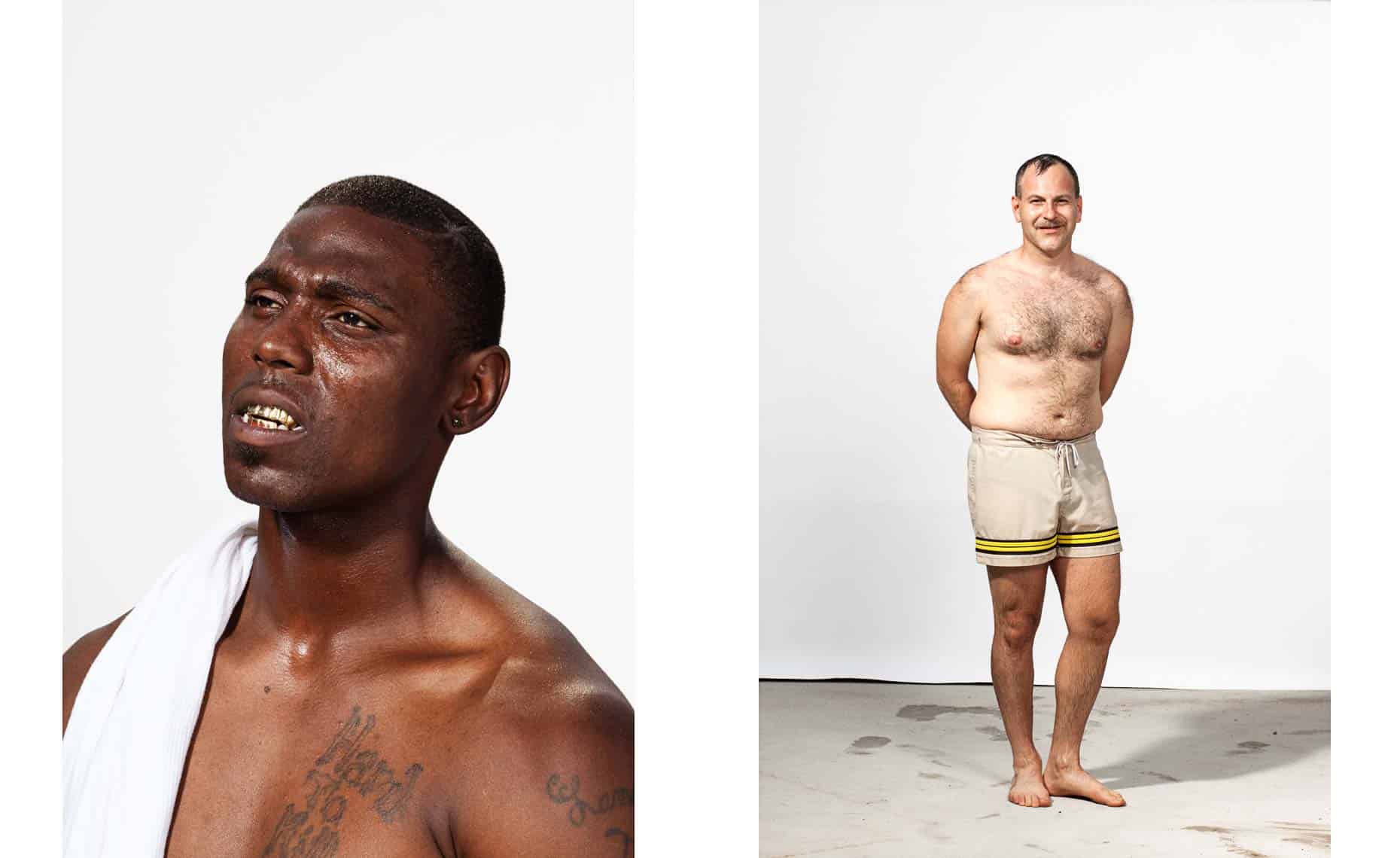
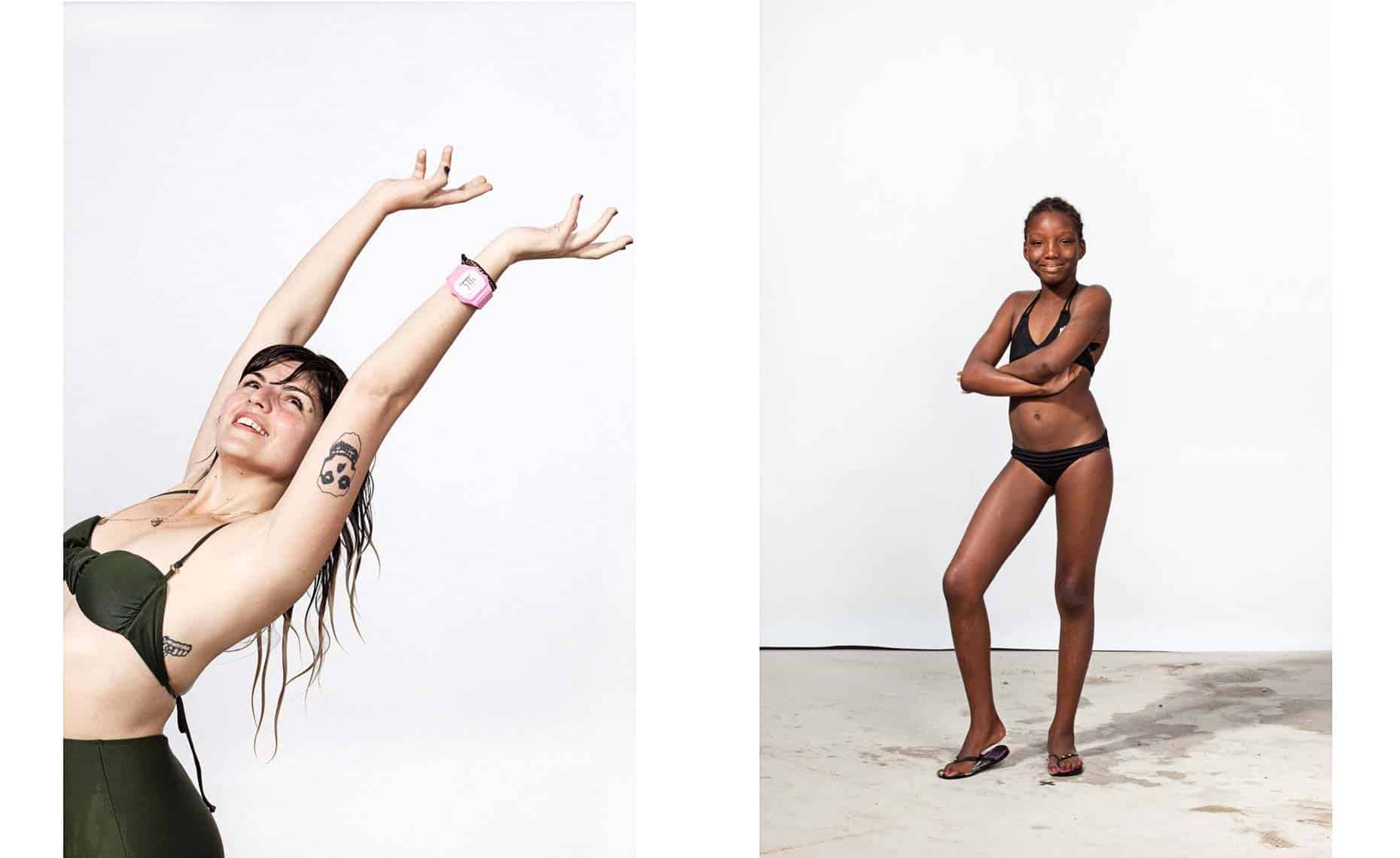
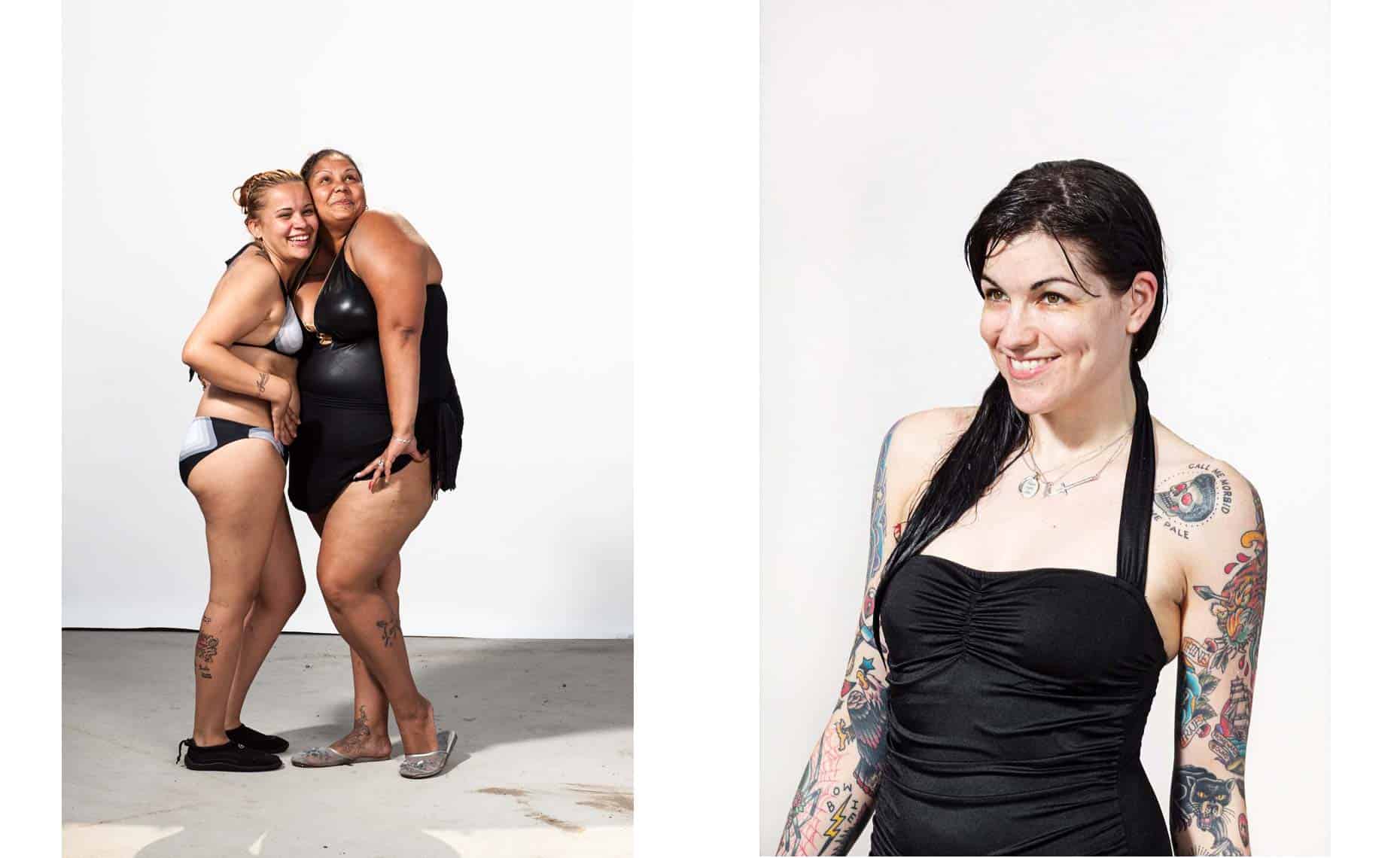
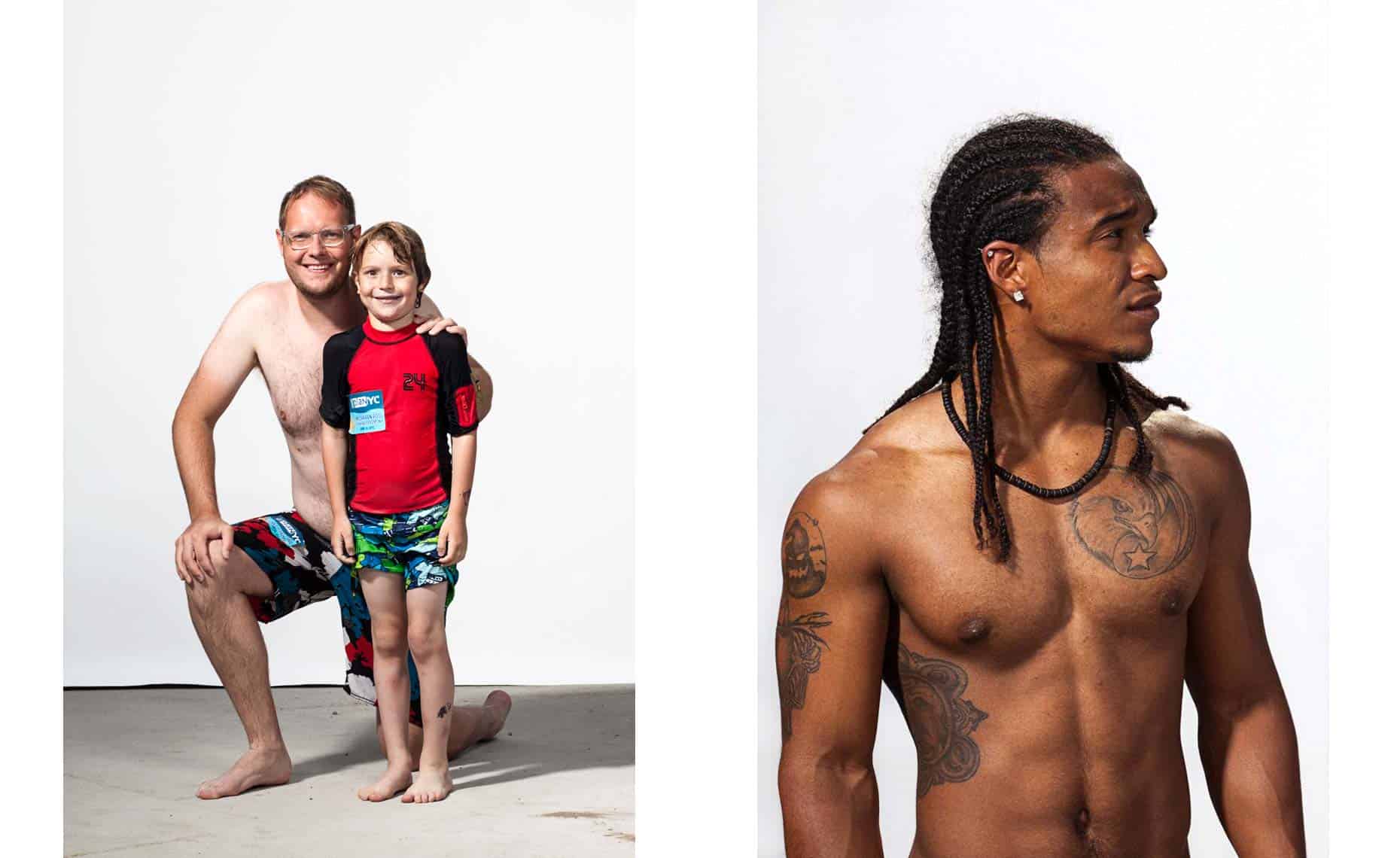
McCarren Pool Portraits – Tim Soter
It’s like, does he, you know, I think the question of exploitation comes up in how did they think they were going to be represented?
Right.
Did they think that, or did they know, did he explain like what the photo was going to look like, did he show them, depending on he shot, did he show them. If they saw it, how would they feel?
That is an interesting point, and somebody else had kind of mentioned that too. And I have to assume that this is a limited edition fine art photography book, the people never…
Yeah, the odds are slim to none.
Yeah, slim to none they’ll ever see it again, but also the position of the camera and where they are, it’s obvious he’s not using a lens where he’s ten feet back…
No, he’s right there!
He’s in their face, so regardless of what they’ve been told or anything they have to know, this is the photo. So I don’t know, I didn’t see any interviews with him about this process. And I went to the book signing at Dashwood Books, and Bruce was there. He’s around, he’s irascible, he’s that guy, you know. He’s great. But I forgot to ask him. I went there thinking, “Oh I should really ask him,” and I got sidetracked or something. I don’t know that he would have necessarily told me a detailed plan. He might keep it close to the vest. But that’s a very interesting book; it’s kind of in the middle there. You just have to go with your personality. Like you and I, I couldn’t jump out at somebody. I could do some street photography, I love LOVE reportage and shooting the story. But I can’t really be a jerk…..yeah…go with your personality, that’s the only way.
Here’s what kind of winds me up a little bit. Everybody’s putting out self-published photo books right now, myself included, it’s just that era. We can do it at a nice price point, but when you go to book fairs, like the PS1 book fair which is pretty good but boy do you see the same book over and over and over and it’ll be like….one person put it best, they said, “Yeah and it looks like somebody did it with one roll of film and they walked around the most boring German town and they shot the same flat black and white photos of the most boring parts of the boring German town” ….and now it’s a $60 book and you’re thinking, “Who is buying that book?!” It doesn’t make any sense to me. Or you see a zillion books that are two steps removed from Terry Richardson or Vice Magazine ten years ago. Or it’ll be like a girl in a loose tank top, biting her lip and slouching…
With a flash.
Yeah, with a flash, and then next to that will be a picture of just some cigarette butts in a gutter shot close up. And at PS1 book fair, there were a ton, a ton of these books. And to me, I didn’t see almost anything where I thought, “Oh, I’d be excited to look at this over and over and over again.” And you have to have some sort of criteria.
You have to have a criteria because, when I look at my curated book shelf, you know, the books that are on there, for the most part are solid. This is the criteria for making a good photo book. If you’ve owned this book for a year, you see the spine on your bookshelf one Saturday, and you’re like, “Wow, I haven’t looked at that in a while.” And you pull it off the bookshelf, and you’re pretty happy. Some of the books that people are putting out now, I look at it once and I think, “I would never want to look at this again.” Not even that it’s so bad. It’s just that I got all of the information, and it’s not information that’s interesting enough to want to revisit, either in its beauty or its message, and I put it back down on the table.
Right.
“I’ve just done it; I don’t need to look at it again.” This person didn’t have a good criteria, or maybe I just don’t bond with it. But I don’t really think that….there needs to be….the “Tim Go Away!” book. I’m just saying why I think my book is interesting is because it has a huge narrative in it. And it’s really personal, and there’s a real story there and there’s a lot of writing there. And it actually has an ending, where I have to get to this point where I’m think, “all right you’ve lead this person up to here, now what are you going to go do?” And I do get that in my own way in the ending.
So I have a criteria for things. I wanted it to be something you look at again and again and again, but there are a lot of photo-books or a lot of photo projects where I don’t think people think like that. They think, “I did twenty-four of the same idea, it’s done! You see? I did 24 of them?”
Or something like that. But what’s the point, you know? I do think that’s really important in terms of going back to why do anything you know, why make photographs? Why inundate a world full of photographs? Having a criteria is really going to be help that out. Not just feeling, “Oh I’m a part of this, I’m participating.”
Yeah, and I feel, that is the downside of the proliferation of photos, that there are just so many mediocre photos because there are so many people who kind of have no criteria. They like shooting or they like shooting what they saw somebody else do. I feel like so much of Instagram or you know the internet is people following a path. “Oh here, let’s follow this path because it has been well trod” vs “let’s go somewhere nobody else has gone.”
Yeah exactly. I think, yes, some people just want to go in and show their over-intellectualized idea. There are so many where yes, people are mirroring other people and it feels good. And also these pseudo-lofty ideas where I think, “who the hell can connect with this shit?” And you know what, it’s one of either two things, and a lot of life is like that. I personally have a difficult time making decisions because I think, “oh it could be this or it could be this” and it’s too much- I see the merits of both. But it’s one of two things, either it IS a book that they just put out and it’s their own weird ideas that I personally don’t connect, but the world is so big that a few other people will pick up their book and say, “Oh man this is weird and right up my alley, and I connect with this.”
OR it’s that people are making semi-terrible photo books, that their ideas are so disconnected and there’s not a narrative, that it’s just a big mish-mash, and they’re hoping that they’ve bluffed their way into something. And it’s nonsense, and there’s a ton of that stuff. I like to be relaxed enough to say, “ok maybe it’s a little bit of both,” but I definitely lean on the side of, “You haven’t thought this out and thought about what the audience might be, or tried to connect with people.” But maybe that’s part of art, is not thinking about your audience and just putting your ideas out there and getting to see who connects with it. But I don’t subscribe to that.
I’m of the older school where not everything can be art. Like, the new school is everything can be art, the possibilities are endless. I like there to be constraint. Like…there has to be…if everything is art then nothing is art. You know it’s like…
Oh yeah. I’m from the era of the “lineage” you know a great line where this begat this begat this begat, Robert Frank begat…you know on and on and on. And criteria matters, and that’s the way you advance things forward. You build off of other things, and you push it even further. And I don’t see a lot of stuff that’s really….that’s pushing it further. It takes a lot of work and thought, and it’s scary to push things. I see a lot of the samey-same-same, and that doesn’t push things further.
You know after that rant people are going to say, “This book better be amazing, Soter!”
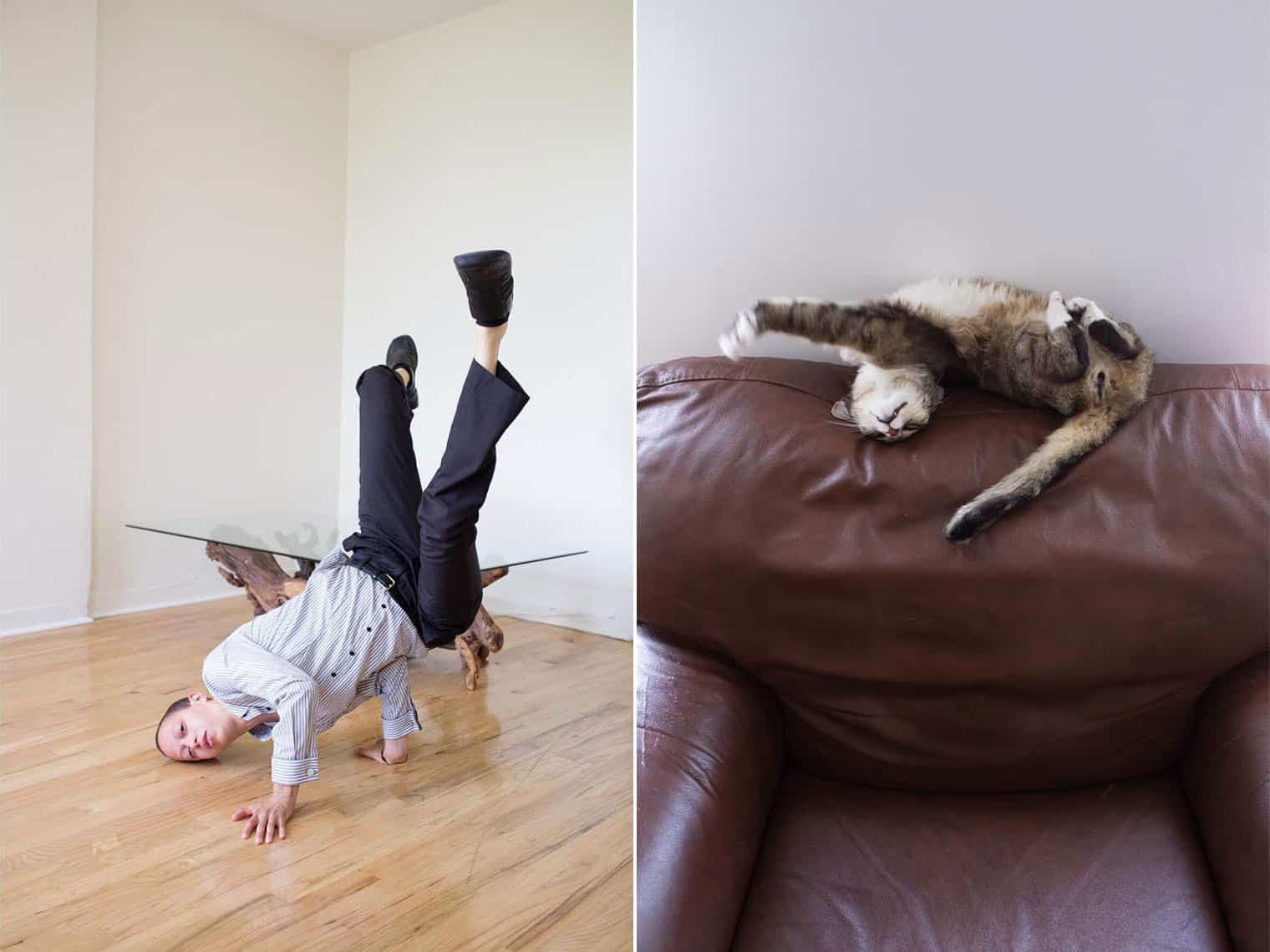
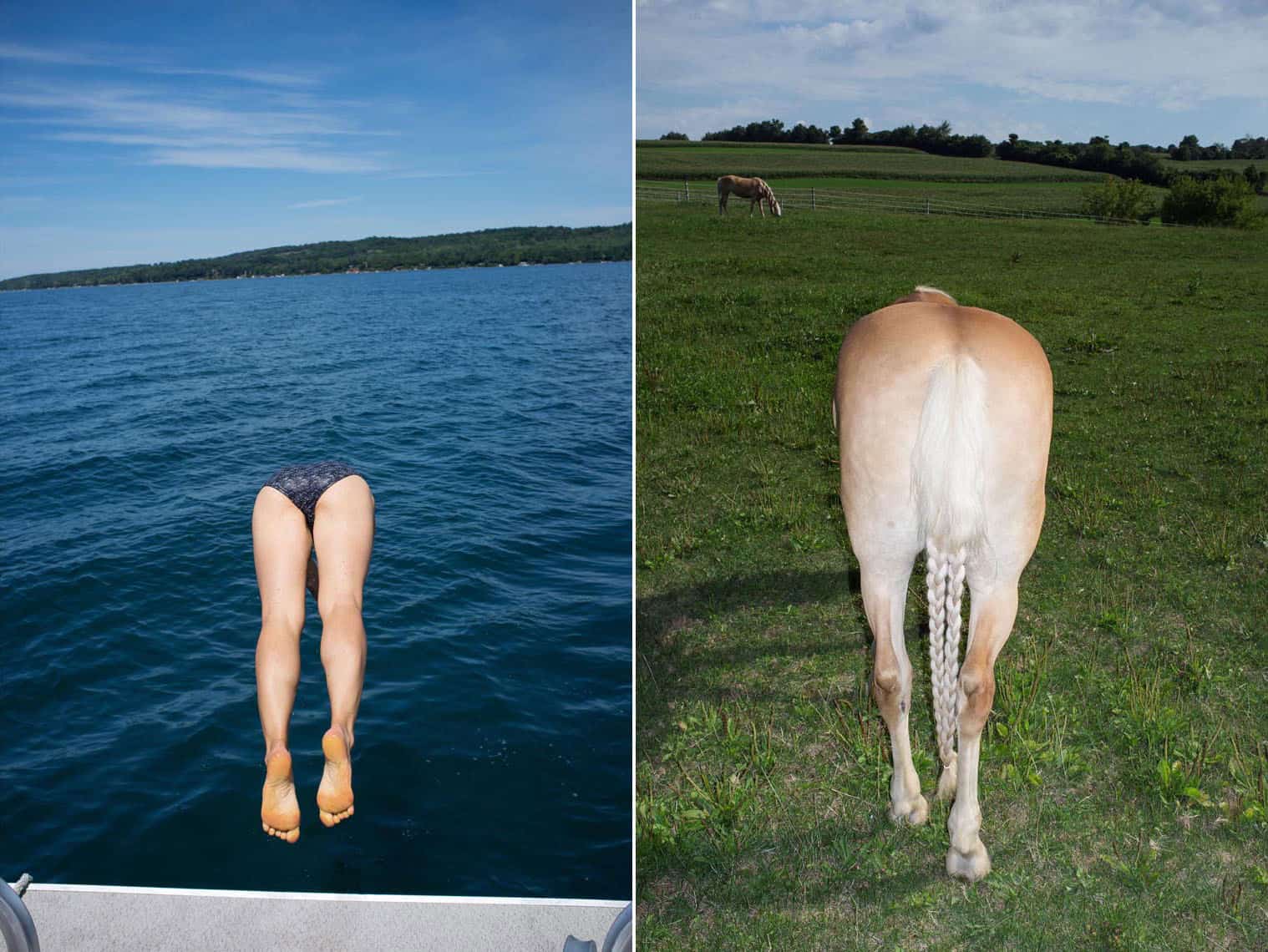
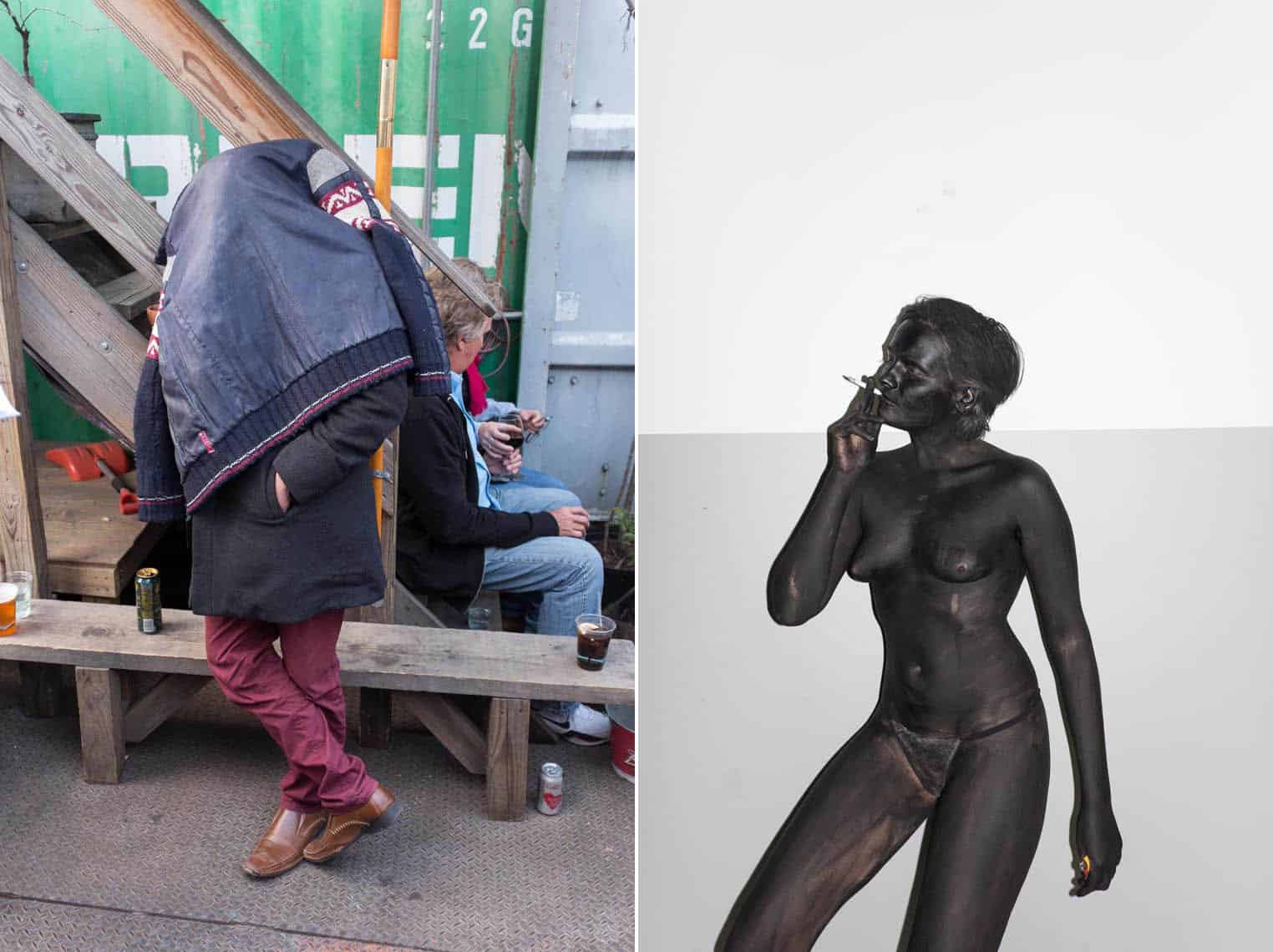
Yeah, you’ve set the bar very high, you better change everything.
Ok, good! I believe that I’ve done the most I can actually do in making something – because it’s personal, and I’m sharing a lot of my own nutty thoughts with strangers.
There’s something very attractive about the idea of a photo book as a…not a full biography but a memoir of your experience with a person.
Yeah, and this one doesn’t even get to the fact that now Duane and I are friends. This is more like obsessing about somebody and then trying to figure out why you do that or why you connect with their work. There must be a photographer where you’re, “Oh my god I love so-and-so’s work.” You know that turned me on to this, “Oh my god I would love to have all of their books and just eat them! You know I’d love to live with their actual prints.” I think everybody’s got people who are heroes or mentors or whatever they are, but people just don’t really talk about that. It’s a very strong thing, but it just doesn’t come up in conversation. So that’s what I really wanted to get at, what is that thing?
I mean, because when you were telling me…I think like right when I was coming to the interview and I was seeing the Arthur Tress stuff you were talking about, I was like, “Oh this is…that would make a fantastic series; like these are my experiences with these other people.”
John Saunders, he’s an LA photographer, who is really great. He said, “Well, you gotta do a third one. It’s three. It’s gotta be three. Three is a whole thing; it’s gotta be three.” But there isn’t another person. But he’s like, “You better find another person.”
You better start loving somebody and become obsessed with somebody soon!
Yeah, so he said, “What about Robert Frank?” Of course I sarcastically responded “Yeah, he’s very accessible….”
And so now, do you find that you’re doing more personal work, or more commercial work?
Now I have to figure out how again to balance the two; art and commerce. And ask what I really want to do. This year, when people ask, “Oh, how’ve you been?” I think, “How am I going to answer this one? How have I been? What’s the photographer’s answer?” I have had a bunch of good jobs this year, but they never come to mind. Maybe there’s some sort of tell there. The first thing that comes to my mind is, “I’ve been hanging out with Duane Michals.” And that’s really where my head has been.
Duane decided about a year ago that he really wanted to try and make short films, you know about 6-8 minutes long. So he just made one, and it was goofy, and came about very naturally, and so he said, “Oh, let’s make another one.” It wasn’t like this grand scheme. But this year I think I worked on nine short films with him. Sometimes I’m helping direct with the camera, or you know, just doing whatever, writing down the dialogue so people can read it. It’s just like making a fun “Ye Olde Timey” movie. But there are some that are very sophisticated, and have a deeper mood to them. Some are lighter fare, just funny and comical ones. But it’s great! It’s like skipping grad school, (I didn’t go to grad school) It’s like skipping grad school and saying, “Oh I’m going to go study with Duane Michals this year. And since I don’t shoot a ton of video, I’m going to learn about video and editing and making these little movies.”
And so that’s pretty much what I’ve been doing this year when I think about where I’m headed. It’s just really spending time with the very accessible master photographer, who’s very funny, and learning from him. And this book’ll come out, and that’s coinciding with this relationship. And at some time I know that I have to really get back to, “all right, well, what’s my work?” You know if I take away my Arthur and Duane projects, what is my work? But if I really relax, I think, “no one cares, nobody is judging me, that IS my work.” Those relationships and turning them into projects, but not thinking about them beforehand and preying on somebody, that is the work. Just having it be, “well, I spent a few years with that person and I photographed them a bunch, what if I did a book?” With Arthur, I waited four years and suddenly thought, “Oh, I guess that would be interesting to make a book out of this.” But it wasn’t like I was thinking about that the whole time.
So that’s really where I feel I’m at. Like last week when I went to Duane’s I was helping edit one of the films. His assistant Josiah is a great editor, I was helping him a little bit with some ideas or something. We’re in the print room at Duane’s house, and I said, “Oh I’d love to look at some prints.” I wanted to look at a specific print, and he points to a box on the shelf, “Well it might be in this box.” So we pull out the box, and here we are looking at beautiful, fifty year-old, silver gelatin archival prints. When I turn around, in this room, it’s just boxes and boxes and boxes. And they’ll say, “Magritte” or “Paradise Regained” or anybody you can think of, or any sequence that he’s done. It’s amazing. Or the book titles are written on the print boxes. And they’re just there! It’s super exciting! Who else has access to that? I don’t want anything more than that.
So that’s where I’m at right now in my photography career. If I relax, and I’m not competitive and I don’t want a quick response answer to a photo editor who might hire me or something like that and I’m just speaking frankly… I’m where I want to be right now. My life is actually pretty good. I’ve gotten to a place you couldn’t buy your way into. It’s really specific to me, this is the most exciting place I would want to be, and that’s kind of where I’ve put myself naturally, without forcing it. It kind of worked out. It’s nice.
Well I think that about does it, that’s it for us.
Excellent! I love, love talking about photography. So this is a well spent Sunday; this is really nice.
Thank you so much.
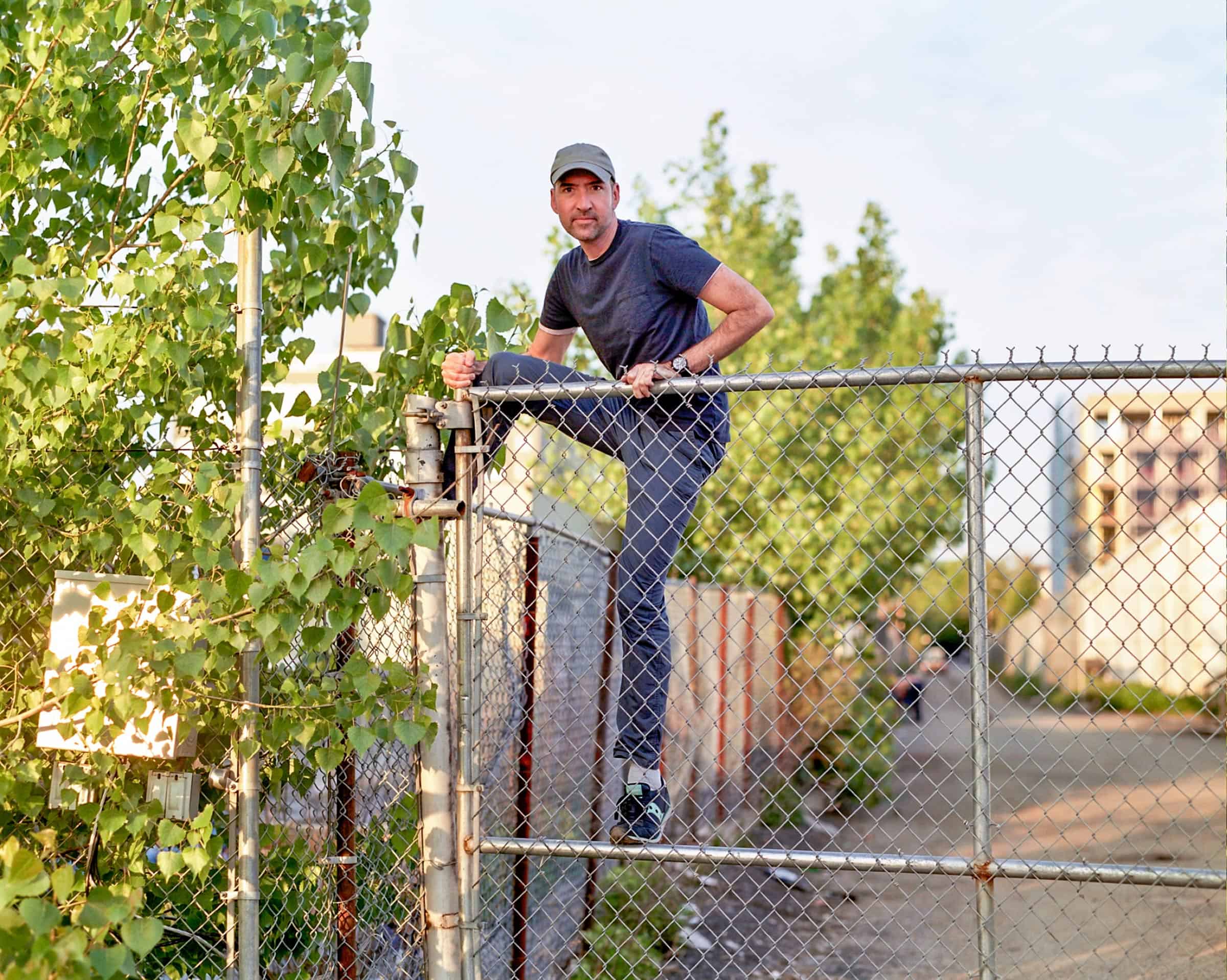
Tim Soter – Photographed by Simon Zachary Chetrit